Transient Fault Detection and Location in Power Distribution Network: A Review of Current Practices and Challenges in Malaysia
Abstract
:1. Introduction
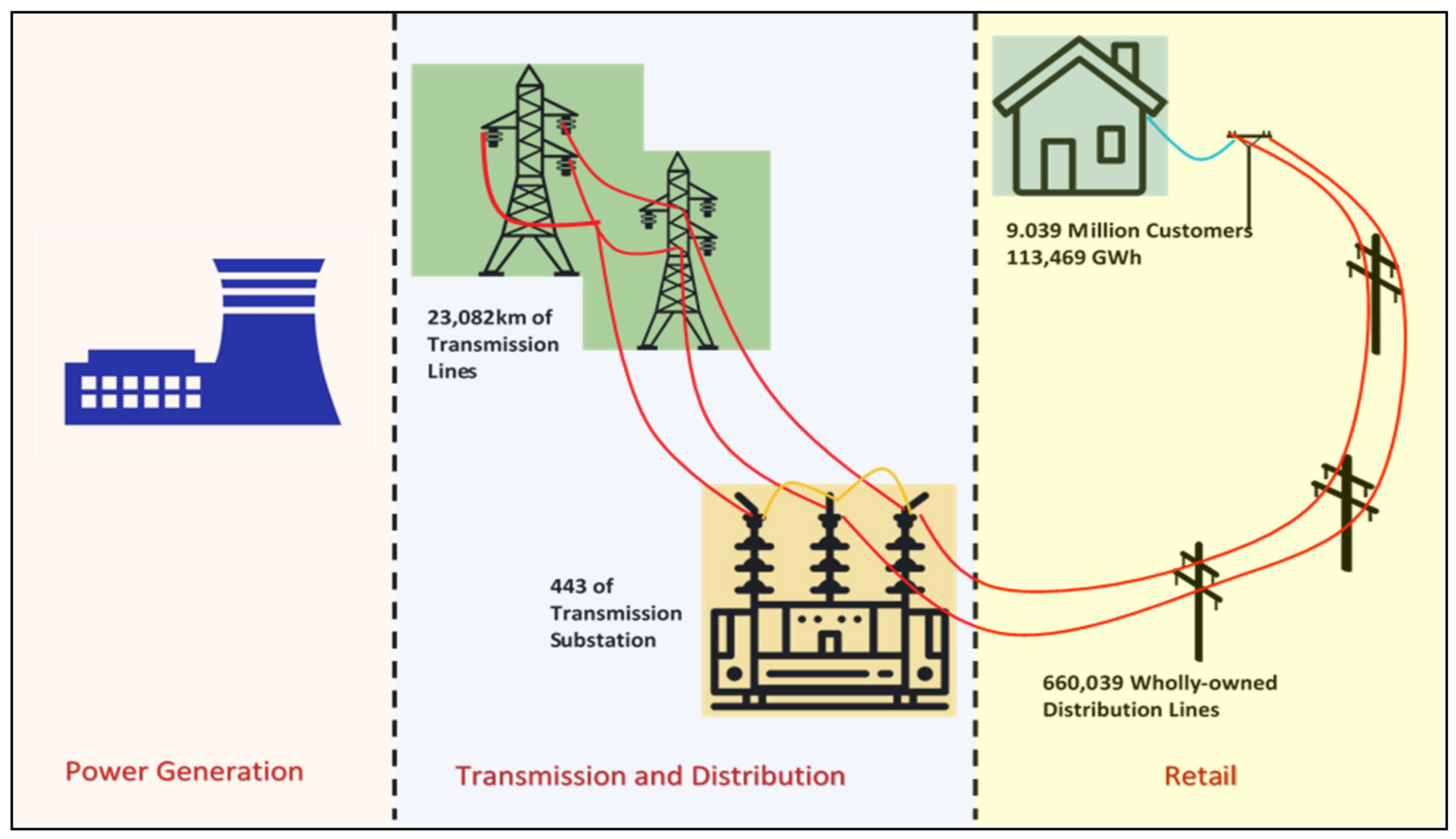
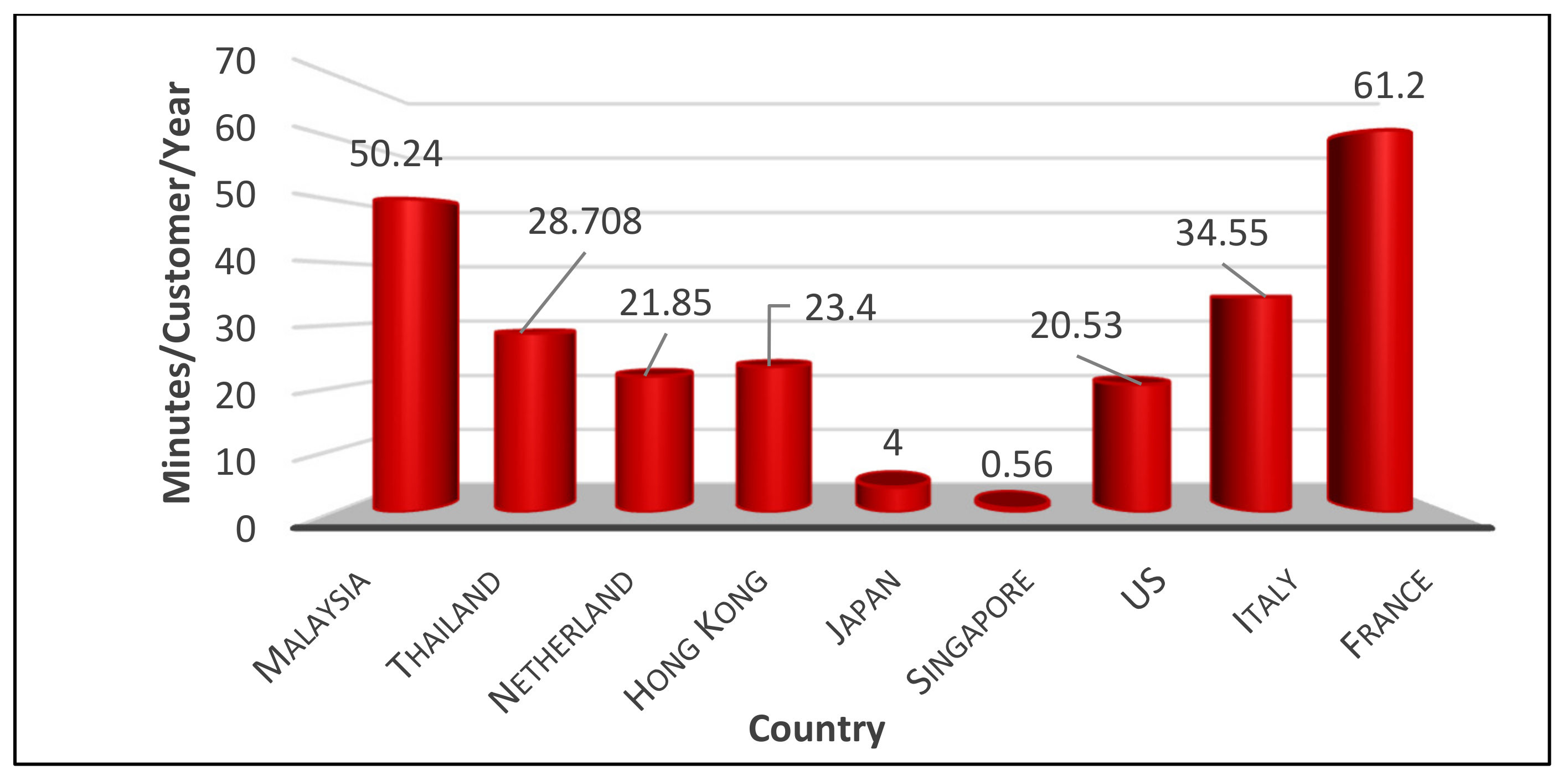
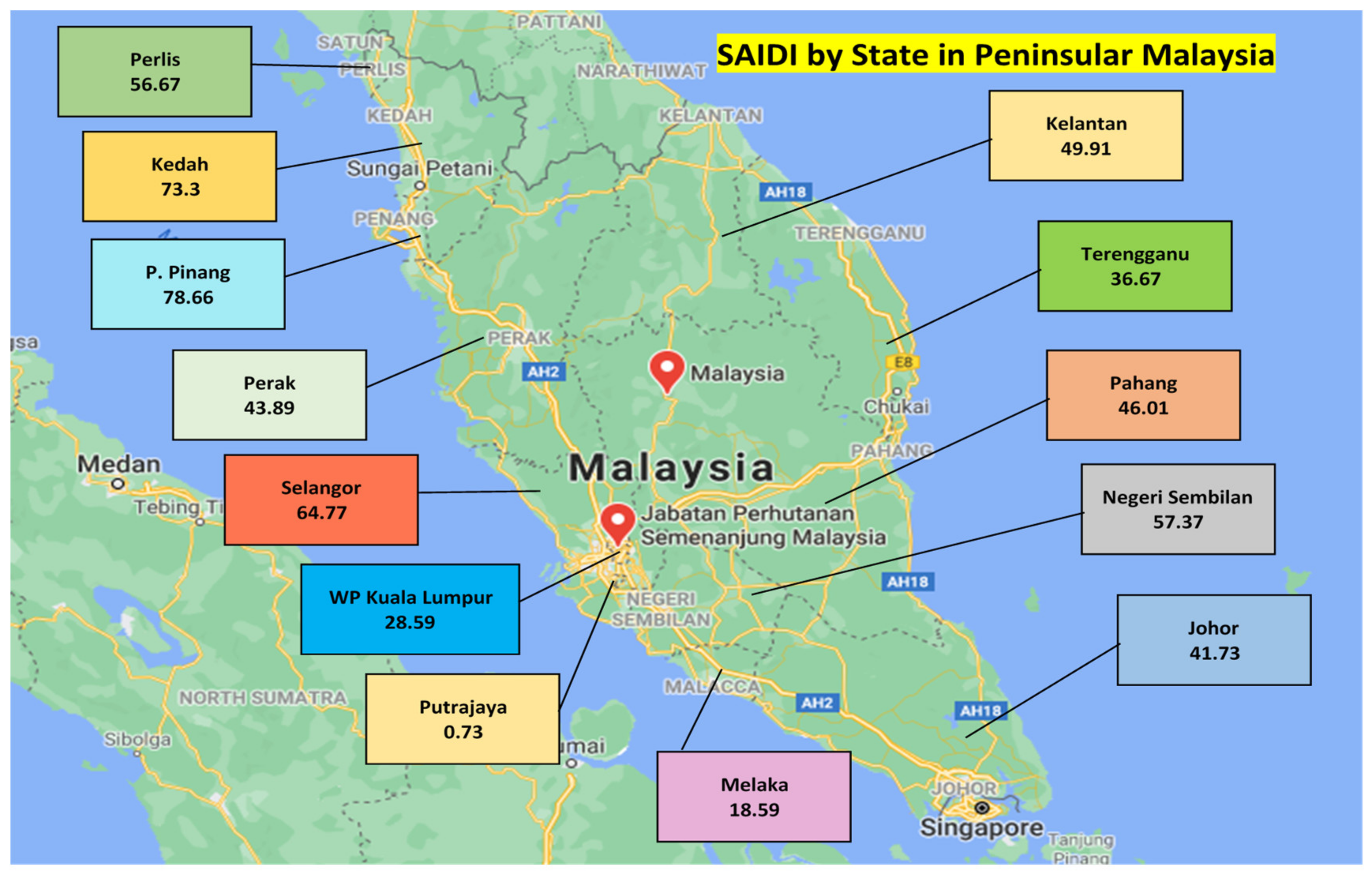
| Standard | Title | Outline | Description |
|---|---|---|---|
| IEC Standard 60909 [9] | Short-circuit currents in three-phase A.C. Systems | Calculation | Maximum and minimum prospective short-circuit currents in a system for every specific location and time |
| IEC Standard 61000-3-6 [19] | “Assessment of emission limits for distorting loads in MV and HV power systems” | Installation | Emission limit for harmonic emission in MV |
| IEC Standard 61000-3-7 [20] | “Assessment of emission limits for fluctuating loads in MV and HV power systems” | Installation | Chapter 8: “Emission limits for fluctuating installations connected to MV systems” |
| IEEE-1159 [21] | “Recommended Practice for Monitoring Electric Power Quality” | Measuring and recording | Chapter 5: “Monitoring objectives” |
| IEEE Std C37.114™-2014 [22] | “Guide for Determining Fault Location on AC Transmission and Distribution Lines” | Measuring and recording | Chapter 5: “Other Fault Location Application” |
| IEEE Std C37.011™-2011[23] | “Guide for the Application of Transient recovery Voltage for AC High Voltage Circuit Breakers” | Procedure and calculation | Chapter 3: “Transient Recovery Voltage” |
| IEEE Std 1894™-2015 [36] | “Guide for Online Monitoring and Recording Systems for Transient Overvoltages in Electric Power Systems” | Measuring and recording | Chapter 4: “The configuration and functions of online monitoring and recording systems for transient overvoltages in power systems” |
| IEEE Std 1729™-2014 [24] | “Recommended Practice for Electric Power Distribution System Analysis” | Model Design | Chapter 4: “Recommendation for test feeder” |
| IEEE Std 551™-2006 [37] | “Calculating Short—Circuit Currents in Industrial and Commercial Power Systems” | Calculation | Chapter 12: “Short-circuit calculations under international standards” |
| IEEE Std 399-1997 [25] | “Recommended Practice for Industrial and CommercialPower Systems Analysis” | Measuring and recording | Chapter 11: “Switching Transient Studies” |
| IEC 61850 [9] | “Standard for SCADA” | Communication and Design | Lecturer 5: “Standard for the design of substation automation” |
| IEEE 802.15.4 [28] | “Standard for Low-Rate Wireless Networks” | Communication and installation | Chapter 5.2.1: “Smart Utility network” |
| IEC 62351-7 [29] | “Communication and Information Management Technologies” | Security Measures | Part 7: Security Through Network and System Management |
| IEC 60870-5 [30] | “Telecontrol Function” | Communication | Part 5: Communication profile for sending basic telecontrol messages between two systems, which use permanent directly connected data circuits between the systems. |
| IEC 60255-24:2013 and IEEE Std C37.111-2013 [31] | “Measuring Relay and Protection Equipment” | Data Exchange | Part 24: Common format for transient data exchange (COMTRADE) for power systems |
| ANSI C12-19-2012 [32] | “Utility Industry End Device Data Tables” | Application data | Part 19: Table structure for utility application data to be passed between an Device and any other device |
2. Fault Categories
2.1. Temporary Fault
2.2. Permanent Fault
3. Unbalanced Fault in Power Distribution System
3.1. Series Fault
3.2. Shunt Fault
4. Transient Faults in Malaysia
4.1. Transient Classes
4.1.1. Impulsive Transient
4.1.2. Oscillatory Transient
4.2. Transient Fault Protection System
- The shape of the lightning current—peak value, front time, tail time, and duration.
- Polarity.
- Multiplicity of number of components in a flash.
| Event | Description |
|---|---|
| Capacitor switching [21,36,63,64,65] |
|
| Lightning [67,68,69,70,71,72,73,97,98,99] |
|
| High Impedance Fault [100,101,102,103,104,105,106] |
|
5. Methods and Processes to Detect Transient Faults
5.1. Conventional Methods
5.1.1. Travelling Wave Method
5.1.2. Impedance Based Method
| Ref. | Terminal | Network | Parameters | Fault Types | Source of Fault | Ref. | Terminal |
|---|---|---|---|---|---|---|---|
| TL | RDS | Fault Resistance (Ω) | Inception Angle (°) | ||||
| [112] | One | ✓ | 10 to 300 | N/A * | SLGF | N/A * | |
| [110] | One | ✓ | 1 to 30 | N/A * | SLGF | Transient | |
| [123] | Double and Multi | ✓ | 0.1 to 300 | 10 to 90 | SLGF | Transient | |
| [124] | Two | ✓ | 10 | 0 | SLGF | N/A * | |
| [125] | One | ✓ | N/A * | N/A * | SLGF | Transient |
5.2. Data-Driven Methods
- Artificial Neural Network (ANN) including:
- -
- Convolutional Neural Network (CNN).
- -
- Long Term and Short Term Memory Network (LSTM).
- Fuzzy Logic.
- Support Vector Machine (SVM).
- Genetic Algorithm.
5.2.1. Artificial Neural Network
5.2.2. Fuzzy Logic
5.2.3. Support Vector Machine
5.3. Features Optimization
Genetic Algorithm
- Selection: The process where the solutions should be preserved (allowed) or deserve decay. The best solution will be selected, and others will be discarded. Here, fitness function and optimality will be quantified.
- Crossover: A new solution is created from existing available solutions after the selection process.
- Mutation: Introducing of novel features into the solution to preserve the population diversity.
5.4. Signal Processing Methods
5.4.1. Wavelet Transform
5.4.2. Stockwell Transform Approach
5.4.3. Empirical Mode Decomposition Approach
6. Challenges and Recommendations of Future Trends Schemes
6.1. Challenges of Transient Fault Detection in Malaysian Distribution System
6.2. Future Recommendations
- Several transient faults occurred in Malaysia recorded in the backwoods territory, which is difficult to be patrolled by the crews when there is a fault. Therefore, autorecloser installation in the backwoods should be increased to reduce the interruption times, thus potentially reducing the SAIDI performance.
- Due to the increased number of new technologies implemented in the Malaysian grid system, the existing standards and guideline should be regularly revised to achieve permissible leniency of the equipment to prevent damages and any unplanned system faults. For example, the evolving technology of battery energy storage needs an extensive revision on the current electrical standard since the deployment is still new in prevailing any upcoming damages.
- With the rapid progress of AI, neural networks are becoming more popular, but the limitation is still serious in the training. Big data are required for the training of every situation. However, faults are not that often, so the fault data are always small data. Several methods that could overcome the limitation exist, including creating a model that yield signals similar to the actual field data. The parameters in the created model are varied to obtain various simulation results within the actual range values. Another solution is generating synthetic data where the data production is applicable to real situation. The data are artificially created by programming based on the original data set.
- The lack of fault detection and location computation time contribute to the low distribution system performance. Furthermore, the main challenge for these methods is that they rely on huge amounts of representative data and cannot extrapolate beyond the boundaries of the training data. Therefore, hybrid approaches that make use of knowledge-based methods such as the wavelet method along with data-driven machine learning-based methods such as ANN can address the aforementioned problem effectively. Therefore, the classification of the fault and the clearance time of the power compensation device could be faster.
- Due to the boost of RE deployment in the Malaysian grid system, an appropriate planning and scheduling power dispatch should be deliberated. This will help to reduce the risk of fault, hence escalating the RE source generation in the Malaysian distribution system.
7. Conclusions
- Various techniques and improvement methods have been adopted to detect and locate various types of transient faults to mitigate power outages in the system. Various mathematical algorithms and AI approaches have been proposed to acquire an accurate fault location at a very fast speed. All parameters to acquire fault detection and location are tabulated and summarized in Table 6, whilst basic principles, advantages, and disadvantages of previous works associated with each technique are investigated and summarized in Table 7. The efficiency and robustness of individual approaches are also assessed to comply with the selected bus system. The lightning strike is prescribed as the dominant cause of transient faults and might damage the system. As a result, the system will suffer from power outages and reduced quality of power delivery.
- From the studies conducted, fault detection and location can be categorized into conventional and knowledge-based methods. The conventional methods are economical and simple measurement setups that require less computation time. Among the conventional methods, those that are impedance based have the simplest algorithm. However, it is inaccurate for large power system networks where their application is limited due to the randomness of the grounding resistance and load fluctuation. Meanwhile, the travelling wave method is a standalone in the network configuration and needs to be installed in the presence of lateral branches of the distribution network, which is very costly. On the other hand, knowledge-based methods using AI are widely used due to their high accuracy in identifying a fault location, even in a large system, simple structure, and non-linear mapping ability. Since the conventional distribution network is under transformation to a more efficient system, this transition puts forward increased stress on the complex infrastructure for further investment to ensure safe and reliable energy supply to the consumers. Therefore, efficient and intelligent mechanisms for fault detection and location must be formulated.
- All the reviewed AI techniques have shown promising performance in terms of fault detection and location accuracy. Based on summarization of all Artificial Intelligence methods in Table 8, SVM is seen as the most robust machine learning method to be implemented in Malaysian power distribution system. This is due to the fact that SVM has no requirement for a large amount of training data, and very fast computation speed with the lowest percentage error. However, it is suggested to configure with wavelet transform (WT) to overcome the extrapolation problems since WT has the simplest structure of transient detection process.
- Transient fault is found to be the most frequent disturbance in Malaysian electrical systems. Transient fault has become a matter of concern nowadays, along with permanent faults, but has gained the least attention from researchers based on previous works [4,223,224,225,226]. Further, SLGF is disclosed as the most the popular approach for the evaluation of fault types in this paper due to common occurrences as shown in Table 6.
- Several key challenges and recommendations for future transient fault detection and location in Malaysia have been addressed. Due to super-fast technology evolution, the bulk of electronic devices will be installed and shall not be overlooked when developing new fault detection and location methods. In order to implement a reliable distribution automation (DA) system, the enrolment of a digital fault recorder (DFR) with a robust AI technique adopted in distribution substations shall be introduced where better measurement and communication infrastructures are deployed. The methods shall be accurate and reliable enough to meet the future distribution systems’ requirements in terms of continuity of supply. In this regard, the required investments, reliability, and techno-economic benefits of different schemes require broad investigations and further exploration. Technically, the key success criteria is to suit the selected technology in the Malaysian system that depend on different factors such as the topology of the distribution system under study, the availability of data and measurements, and the desired functionalities and objectives.
Author Contributions
Funding
Institutional Review Board Statement
Conflicts of Interest
References
- Barros, J.D.; Ferreira, E.F.; Barros, J.D. Faults Monitoring System in the Electric Power Grid of Medium Voltage. Procedia Comput. Sci. 2018, 130, 696–703. [Google Scholar]
- Trindade, F.C.L.; Freitas, W. Low Voltage Zones to Support Fault Location in Distribution Systems with Smart Meters. IEEE Trans. Smart Grid 2017, 8, 2765–2774. [Google Scholar] [CrossRef]
- Barakat, M.A.; Hatata, A.Y.; Badran, E.A. Protection of transformer due to external fault between two voltage levels using overvoltage protection and sequence component of currents. Electr. Power Syst. Res. 2020, 184, 106339. [Google Scholar] [CrossRef]
- Zin, A.A.M.; Abdul Karim, S.P. Protection system analysis using fault signatures in Malaysia. Int. J. Electr. Power Energy Syst. 2013, 45, 194–205. [Google Scholar] [CrossRef]
- Costa, F.B.; Lopes, F.V.; Silva, K.M.; Dantas, K.M.C.; França, R.L.S.; Leal, M.M.; Ribeiro, R.L.A. Mathematical development of the sampling frequency effects for improving the two-terminal traveling wave-based fault location. Int. J. Electr. Power Energy Syst. 2020, 115, 105502. [Google Scholar] [CrossRef]
- Rui, L.; Chenglei, L.; Nan, P.; Menghan, C.; Fei, W. Fault location for power grid based on transient travelling wave data fusion via asynchronous voltage measurements. Int. J. Electr. Power Energy Syst. 2017, 93, 426–439. [Google Scholar] [CrossRef]
- Wang, D.; Hou, M. Travelling wave fault location algorithm for LCC-MMC-MTDC hybrid transmission system based on Hilbert-Huang transform. Electr. Power Energy Syst. 2020, 121, 106125. [Google Scholar] [CrossRef]
- TNB. Integrated Annual Report 2017; Baha Malaysia: Kuala Lumpur, Malaysia, 2017. [Google Scholar]
- Nalley, S.; Angelina La Rose, A.A. Annual Energy Outlook 2018 with Projections to 2050. Available online: https://www.globalenergyinstitute.org/eias-annual-energy-outlook-2018-ups-downs#:~:text=Domestic%20Supply%20%26%20Demand%3A%20U.S.%20energy,of%20about%200.4%25%20per%20year (accessed on 20 April 2020).
- Esmail, M.; Sadegh, M.; Hosseinnezhad, V. Reliability modeling of process-oriented smart monitoring in the distribution systems. Electr. Power Energy Syst. 2019, 109, 20–28. [Google Scholar]
- Bahmanyar, A.; Jamali, S.; Estebsari, A.; Bompard, E. A comparison framework for distribution system outage and fault location methods. Electr. Power Syst. Res. 2017, 145, 19–34. [Google Scholar] [CrossRef]
- Weng, G.; Huang, F.; Tang, Y.; Yan, J.; Nan, Y.; He, H. Fault-tolerant location of transient voltage disturbance source for DG integrated smart grid. Electr. Power Syst. Res. 2017, 144, 13–22. [Google Scholar] [CrossRef]
- Bíscaro, A.A.P.; Pereira, R.A.F.; Kezunovic, M.; Mantovani, J.R.S. Integrated Fault Location and Power-Quality Analysis in Electric Power Distribution Systems. IEEE Trans. Power Deliv. 2016, 31, 428–436. [Google Scholar] [CrossRef] [Green Version]
- Amir, S.; Askarian, H.; Hossein, S.; Sadeghi, H.; Razavi, F.; Nasiri, A. An overview of microgrid protection methods and the factors involved. Renew. Sustain. Energy Rev. 2016, 64, 174–186. [Google Scholar]
- Saha, M.M.; Izykowski, J.J.; Rosolowski, E. Fault Location on Power Networks; Springer Science & Business Media: Berlin/Heidelberg, Germany, 2009; ISBN 1848828861. [Google Scholar]
- Zhu, J.; Zhou, N. Analysis of the fault type for adaptive single-phase autoreclosure. IEEE Power Energy Soc. Gen. Meet. 2015, 1, 1–5. [Google Scholar]
- Charbonneau, P.-L. Network Fault Monitoring vs. Network Performance Monitoring. Available online: https://obkio.com/blog/fault-monitoring-vs-performance-monitoring/ (accessed on 20 May 2021).
- Distribution Code For Peninsular Malaysia, Sabah & F.T. Labuan (Amendments) 2017. Available online: https://www.st.gov.my/en/contents/publications/guidelines_electricity/2017/Distribution%20Code%20For%20Peninsular%20Malaysia%20Sabah%20%20F.T.%20Labuan%20Amendments%202017_V5.pdf (accessed on 15 May 2021).
- McGranaghan, M.; Beaulieu, G. Update on IEC 61000-3-6: Harmonic Emission Limits for Customers Connected to MV, HV, and EHV. In Transmission and Distribution Conference and Exhibition; IEEE: Piscataway, NJ, USA, 2006; pp. 1158–1161. [Google Scholar]
- Society, E. IEEE Guide—Adoption of IEC/TR 61000-3-7: 2008, ELECTROMAGNETIC Compatibility ( EMC )—Limits—Assessment of Emission Limits for the Connection of Fluctuating Installations to MV, HV and EHV Power Systems; IEEE: Piscataway, NJ, USA, 2008; ISBN 9780738172859. [Google Scholar]
- Society, E. IEEE Recommended Practice for Monitoring Electric Power Quality; IEEE: Piscataway, NJ, USA, 2009; Volume 2009, ISBN 9780738159393. [Google Scholar]
- IEEE. IEEE Guide for Determining Fault Location on AC Transmission and Distribution Lines. In Proceedings of the IEEE Std C37.114-2014 (Revision of IEEE Std C37.114-2004); IEEE: Piscataway, NJ, USA, 2015; pp. 1–76. [Google Scholar]
- IEEE. IEEE Guide for the Application of Transient Recovery Voltage for AC High-Voltage Circuit Breakers with Rated Maximum Voltage above 1000 V; IEEE Std C37011TM-; IEEE: Piscataway, NJ, USA, 2019; Volume 2019, pp. 1–213. [Google Scholar]
- Society, I. IEEE Recommended Practice for Electric Power Distribution System Analysis; IEEE Std 1729-2014; IEEE: Piscataway, NJ, USA, 2014. [Google Scholar]
- IEEE. Recommended Practice for Industrial and Commercial Power Systems Analysis; IEEE: Piscataway, NJ, USA, 1998; ISBN 1559379685. [Google Scholar]
- Khan, R.; McLaughlin, K.; Laverty, D.; Sezer, S. Design and Implementation of Security Gateway for Synchrophasor Based Real-Time Control and Monitoring in Smart Grid. IEEE Access 2017, 5, 11626–11644. [Google Scholar] [CrossRef] [Green Version]
- Ahmed, S.; Lee, Y.; Hyun, S.H.; Koo, I. Feature Selection-Based Detection of Covert Cyber Deception Assaults in Smart Grid Communications Networks Using Machine Learning. IEEE Access 2018, 6, 27518–27529. [Google Scholar] [CrossRef]
- IEEE Standard for Low-Rate Wireless Networks; IEEE Std 802.15.4-2015 (Revision of IEEE Std 802.15.4-2011); IEEE: Piscataway, NJ, USA, 2016; pp. 1–709.
- Cleveland, F.M. IEC 62351-7: Communications and Information Management Technologies–Network and System Management in Power System Operations. In Proceedings of the 2008 IEEE/PES Transmission and Distribution Conference and Exposition, Chicago, IL, USA, 21–24 April 2008; pp. 1–4. [Google Scholar]
- Sánchez, G.; Gómez, I.; Luque, J.; Benjumea, J.; Rivera, O. Using Internet protocols to implement IEC 60870-5 telecontrol functions. IEEE Trans. Power Deliv. 2010, 25, 407–416. [Google Scholar] [CrossRef] [Green Version]
- IEEE/IEC. Measuring Relays and Protection Equipment—Part 24: Common Format for Transient Data Exchange (COMTRADE) for Power Systems; IEEE/IEC: Piscataway, NJ, USA, 2013; ISBN 2831886376. [Google Scholar]
- American National Standards Institute (ANSI). American National Standard For Utility Industry End Device Data Tables ANSI C12.19-2008; American National Standard Institute: New York, NY, USA, 2014. [Google Scholar]
- Huanzhen, H.; Yong, Z.; Zhenxing, L.; Min, Z. Fault Detection of Modular Multilevel Converter with Kalman Filter Method. In Proceedings of the 2019 CAA Symposium on Fault Detection, Supervision and Safety for Technical Processes (SAFEPROCESS), Xiamen, China, 5–7 July 2019; pp. 251–256. [Google Scholar]
- The Malaysian Grid Code. Available online: https://www.st.gov.my/ms/contents/presentations/malaysian_grid_and_distribution_code_2010/introduction%20to%20grid%20code.pdf (accessed on 15 May 2021).
- Tenaga Nasional Berhad. Reimagining Utility of the Future. In Proceedings of the Conference of the Electric Power Supply Industry (CEPSI 2018), Kuala Lumpur, Malaysia, 17–22 September 2018; pp. 1–344.
- Group, C.A. IEEE Guide for Online Monitoring and Recording Systems for Transient Overvoltages in Electric Power Systems IEEE SA Board of Governors; IEEE: Piscataway, NJ, USA, 2015; ISBN 9780738199115. [Google Scholar]
- American National Standards Institute. IEEE Recommended Practice for Calculating Short—Circuit Currents in Industrial and Commercial Power Systems; IEEE: Piscataway, NJ, USA, 2006; pp. 1–314. [Google Scholar]
- Oh, J.H.; Kim, J.C. Feature extraction of fault currents associated with multi-shot reclosing scheme in power distribution system. Int. J. Electr. Power Energy Syst. 2002, 24, 79–85. [Google Scholar] [CrossRef]
- Milosevic, D.; Djurisic, Z. A new technique for improving stability of distributed synchronous generators during temporary faults in a distribution network. Int. J. Electr. Power Energy Syst. 2018, 100, 299–308. [Google Scholar] [CrossRef]
- Filomena, A.D.; Resener, M.; Salim, R.H.; Bretas, A.S. Distribution systems fault analysis considering fault resistance estimation. Int. J. Electr. Power Energy Syst. 2011, 33, 1326–1335. [Google Scholar] [CrossRef]
- Surisunthon, S.; Tayjasanant, T. Impacts of Distributed Generation’s Locations, Sizes, Operation Modes and Transformer Connections on Voltage Sag Assessment. In Proceedings of the TENCON 2011—2011 IEEE Region 10 Conference, Bali, Indonesia, 21–24 November 2011. [Google Scholar]
- Lubkeman, D.L.; Member, S.; Girgis, A.A. Automated fault location and diagnosis on electric power distribution feeders. IEEE Trans. Power Deliv. 1997, 12, 801–809. [Google Scholar]
- Shi, Y.; Baran, M.E. An Automated Model Based Fault Locating Method for Distribution Systems. In Proceedings of the 2016 IEEE/PES Transmission and Distribution Conference and Exposition, Dallas, TX, USA, 3–5 May 2016. [Google Scholar]
- Chow, M.-Y.; Thrower, J.P.; Taylor, L.S. Neural-Fuzzy Hybrid System for Distribution Fault Causes Identification MO-yuen. In Proceedings of the 1993 Second International Forum on Applications of Neural Networks to Power Systems, Yokohama, Japan, 19–22 April 1993; pp. 427–431. [Google Scholar]
- Gururajapathy, S.S.; Mokhlis, H.; Illias, H.A. Fault location and detection techniques in power distribution systems with distributed generation: A review. Renew. Sustain. Energy Rev. 2017, 74, 949–958. [Google Scholar] [CrossRef]
- Moosavi, S.S.; Kazemi, A.; Akbari, H. A comparison of various open-circuit fault detection methods in the IGBT-based DC/AC inverter used in electric vehicle. Eng. Fail. Anal. 2019, 96, 223–235. [Google Scholar] [CrossRef]
- Youssef, A.B.; Khojet, S.; Khil, E.; Belkhodja, I.S. Open-circuit fault diagnosis and voltage sensor fault tolerant control of a single phase pulsed width modulated rectifier. Math. Comput. Simul. 2017, 131, 234–252. [Google Scholar] [CrossRef]
- Nandi, R.; Panigrahi, B.K. Detection of Fault in a Hybrid Power System Using Wavelet Transform. In Proceedings of the Michael Faraday IET International Summit 2015, Kolkata, India, 12–13 September 2015; pp. 203–206. [Google Scholar]
- Sankaran, C. Power Quality; CRC Press: Boca Raton, FL, USA, 2002; ISBN 0849310407. [Google Scholar]
- Energy Commission of Malaysia. Industri Pembekalan Elektrik di Malaysia; Energy Commission of Malaysia: Putrajaya, Malaysia, 2008; p. 164. [Google Scholar]
- Energy Commission of Malaysia. Electricity Supply Industry in Malaysia; Energy Commission of Malaysia: Putrajaya, Malaysia, 2009; p. 90. [Google Scholar]
- Electricity Supply Industry: Performance and Statistical Information. 2010. Available online: https://meih.st.gov.my/documents/10620/e92bbc28-ff35-4e80-8981-a849b2fce14b (accessed on 15 May 2021).
- Suruhanjaya Tenaga. Electricity Supply Industry Malaysia 2011; Malaysia Energy Information Hub: Putrajaya, Malaysia, 2011. [Google Scholar]
- Suruhanjaya Tenaga. Malaysia Electricity Supply Industry in Malaysia—Performance and Statistical Information; Malaysia Energy Information Hub: Putrajaya, Malaysia, 2008; p. 86. [Google Scholar]
- Suruhanjaya Tenaga. Malaysia Industri Pembekalan Elektrik di Malaysia: Maklumat Prestasi dan Statistik; Suruhanjaya Tenaga Energy Commission: Putrajaya, Malaysia, 2010; p. 103. [Google Scholar]
- Energy Commission. Performance and Statistical Information on Electricity Supply Industry in Malaysia; Suruhanjaya Tenaga Energy Commission: Sabah, Malaysia, 2014; p. 111. [Google Scholar]
- Energy Commission of Malaysia. Performance and Statistical Information on Electricity Supply Industry in Malaysia; Suruhanjaya Tenaga Energy Commission: Sabah, Malaysia, 2015; p. 97. [Google Scholar]
- Energy Commission of Malaysia. Performance and Statistical Information in Malaysia 2016; Suruhanjaya Tenaga Energy Commission: Sabah, Malaysia, 2016; p. 103. [Google Scholar]
- Energy Commission of Malaysia. Performance and Statistical Information on Electricity Supply Industry in Malaysia 2017; Suruhanjaya Tenaga Energy Commission: Sabah, Malaysia, 2017; pp. 1–150. [Google Scholar]
- Energy Commission of Malaysia. Performance and Statistical Information on Electricity Supply Industry in Malaysia 2018; Energy Commission: Kuala Lumpur, Malaysia, 2018; pp. 1–132. [Google Scholar]
- Farughian, A.; Kumpulainen, L.; Kauhaniemi, K. Review of methodologies for earth fault indication and location in compensated and unearthed MV distribution networks. Electr. Power Syst. Res. 2018, 154, 373–380. [Google Scholar] [CrossRef]
- Jamali, S.; Bahmanyar, A.; Bompard, E. Fault location method for distribution networks using smart meters. Measurement 2017, 102, 150–157. [Google Scholar] [CrossRef]
- Hasan, M. Study of Switching Transient Over Voltage Due to Transient Short Circuit Fault in a Power Distribution Network. In Proceedings of the 2019 International Conference on Robotics, Electrical and Signal Processing Techniques (ICREST), Dhaka, Bangladesh, 10–12 January 2019; pp. 146–151. [Google Scholar]
- Bollen, M.H.J.; Styvaktakis, E.; Gu, I.Y.H. Categorization and analysis of power system transients. IEEE Trans. Power Deliv. 2005, 20, 2298–2306. [Google Scholar] [CrossRef]
- Ghanbari, T.; Farjah, E.; Naseri, F.; Tashakor, N.; Givi, H.; Khayam, R. Solid-state capacitor switching transient limiter based on kalman filter algorithm for mitigation of capacitor bank switching transients. Renew. Sustain. Energy Rev. 2018, 90, 1069–1081. [Google Scholar] [CrossRef]
- Saad, H.; Rault, P.; Dennetière, S. Study on transient overvoltages in converter station of MMC-HVDC links. Electr. Power Syst. Res. 2018, 160, 397–403. [Google Scholar] [CrossRef]
- Shariatinasab, R.; Kermani, B.; Gholinezhad, J. Transient modeling of the wind farms in order to analysis the lightning related overvoltages. Renew. Energy 2019, 132, 1151–1166. [Google Scholar] [CrossRef]
- Smith, J.C.; Hensley, G.; Ray, L. IEEE recommended practice for monitoring electric power quality. IEEE Std. 2009. [Google Scholar] [CrossRef]
- Mehranzamir, K.; Davarpanah, M.; Abdul-Malek, Z.; Afrouzi, H.N. Discriminating cloud to ground lightning flashes based on wavelet analysis of electric field signals. J. Atmos. Solar Terrestrial Phys. 2018, 181, 127–140. [Google Scholar] [CrossRef]
- Ahmad, N.I.; Ab-Kadir, M.Z.A.; Izadi, M.; Azis, N.; Radzi, M.A.M.; Zaini, N.H.; Nasir, M.S.M. Lightning protection on photovoltaic systems: A review on current and recommended practices. Renew. Sustain. Energy Rev. 2018, 82, 1611–1619. [Google Scholar] [CrossRef]
- Sidik, M.A.B.; Shahroom, H.B.; Salam, Z.; Buntat, Z.; Nawawi, Z.; Ahmad, H.; Jambak, M.I.; Arief, Y.Z. Lightning monitoring system for sustainable energy supply: A review. Renew. Sustain. Energy Rev. 2015, 48, 710–725. [Google Scholar] [CrossRef] [Green Version]
- Lim, S.Y.; Kim, K.H.; Rhee, S.B.; Kim, S.B.; Lee, K.Y. Transient state analysis of lightning surge on distribution systems. IFAC-PapersOnLine 2015, 48, 132–136. [Google Scholar] [CrossRef]
- Borghetti, A.; Nucci, C.A.; Paolone, M.; Bernardi, M. A Statistical Approach for Estimating the Correlation between Lightning and Faults in Power Distribution Systems. In Proceedings of the 2006 International Conference on Probabilistic Methods Applied to Power Systems, Stockholm, Sweden, 11–15 June 2006; pp. 1–7. [Google Scholar]
- Rakov, V.A.; Uman, M.A. Lightning: Physics and Effects; Cambridge University Press: Cambridge, UK, 2003; ISBN 0521583276. [Google Scholar]
- Almeida, A.C.; Rocha, B.R.P.; De Souza, J.R.S.; Monteiro, J.H.A.; Sa, J.A.S. Cloud-to-Ground Lightning Observations over the Eastern Amazon Region: Subsidies for the Protection of Electric Systems. In Proceedings of the 2010 30th International Conference on Lightning Protection (ICLP), Cagliari, Italy, 13–17 September 2010. [Google Scholar]
- Betz, H.D.; Schmidt, K.; Oettinger, P.; Wirz, M. Lightning detection with 3-D discrimination of intracloud and cloud-to-ground discharges. Geophys. Res. Lett. 2004, 31, 1–4. [Google Scholar] [CrossRef]
- Salimi, B.; Abdul-Malek, Z.; Mirazimi, S.J.; Mehranzamir, K. Investigation of short base line lightning detection system by using time of arrival method. Adv. Intell. Syst. Comput. 2013, 182, 141–147. [Google Scholar]
- Li, C.; Xin, Z.; Jianguo, W.; Quanxin, L.; Wenbo, Y.; Yadong, F.A.N. Error Analysis of Total Lightning Location System Based on Monte Carlo Method. In Proceedings of the 2018 34th International Conference on Lightning Protection (ICLP), Rzeszow, Poland, 2–7 September 2018; pp. 1–5. [Google Scholar]
- Naccarato, K.P.; De Paiva, A.R.; Saba, M.M.F.; Schumann, C.; Silva, J.C.O.; Ferro, M.A.S. Preliminary Comparison of Direct Electric Current Measurements in Lightning Rods and Peak Current Estimates from Lightning Location Systems. In Proceedings of the 2017 International Symposium on Lightning Protection (XIV SIPDA), Natal-RN, Brazil, 2–6 October 2017; pp. 319–323. [Google Scholar]
- Cho, H.; Choi, N.; Lee, B. Oscillation Recognition Using a Geometric Feature Extraction Process Based on Periodic Time-Series Approximation. IEEE Access 2020, 8, 34375–34386. [Google Scholar] [CrossRef]
- De Apráiz, M.; Barros, J.; Diego, R.I. A real-time method for time—Frequency detection of transient disturbances in voltage supply systems. Electr. Power Syst. Res. 2014, 108, 103–112. [Google Scholar] [CrossRef]
- Chakraborty, A.; Mandal, R. A Novel Technique Employing DWT-Based Envelope Analysis for Detection of Power System Transients. In Proceedings of the International Conference on Energy, Communication, Data Analytics and Soft Computing (ICECDS), Chennai, India, 1–2 August 2017; pp. 346–350. [Google Scholar]
- Li, B.; He, J.; Li, Y.; Li, B.; Wen, W. High-speed directional pilot protection for MVDC distribution systems. Int. J. Electr. Power Energy Syst. 2020, 121, 106141. [Google Scholar] [CrossRef]
- Rasoulpoor, M.; Banejad, M. A correlation based method for discrimination between inrush and short circuit currents in differential protection of power transformer using Discrete Wavelet Transform: Theory, simulation and experimental validation. Int. J. Electr. Power Energy Syst. 2013, 51, 168–177. [Google Scholar] [CrossRef]
- Ali, E.; Helal, A.; Desouki, H.; Shebl, K.; Abdelkader, S.; Malik, O.P. Power transformer differential protection using current and voltage ratios. Electr. Power Syst. Res. 2018, 154, 140–150. [Google Scholar] [CrossRef]
- Peres, L.M.; Silva, K.M. Power transformer protection using an instantaneous-current-value negative sequence differential element. Int. J. Electr. Power Energy Syst. 2019, 108, 96–106. [Google Scholar] [CrossRef]
- Ukil, A.; Yeap, Y.M.; Satpathi, K. Power systems frequency estimation using amplitude tracking square wave for low-end protective relays. Meas. J. Int. Meas. Confed. 2019, 141, 70–84. [Google Scholar] [CrossRef]
- Chano, S.R.; Miller, D.; Afonso, J.; Allen, M.; Balasiu, F.; Best, M.; Crellin, R.; Deronja, A.; Donahoe, K.; Fontana, D.; et al. Ancillary Protective and Control Functions Common to Multiple Protective Relays; IEEE: Piscataway, NJ, USA, 2011; ISBN 9781457704963. [Google Scholar]
- Ahmed, M.M. New Supervisory Control and Data Acquisition (SCADA) Based Fault Isolation System for Low Voltage Distribution Systems. In Proceedings of the International Conference on Computer and Communication Engineering (ICCCE’10), Barcelona, Spain, 10–11 June 2021; pp. 1–6. [Google Scholar]
- Ahmed, M.; Lian, S. Novel Automated Fault Isolation System on Low Voltage Distribution Automation System. In Proceedings of the 2013 UKSim 15th International Conference on Computer Modelling and Simulation, Cambridge, UK, 10–12 April 2013; pp. 593–599. [Google Scholar]
- Zhang, S.; Rong, J.; Wang, B. A privacy protection scheme of smart meter for decentralized smart home environment based on consortium blockchain. Int. J. Electr. Power Energy Syst. 2020, 121, 106140. [Google Scholar] [CrossRef]
- Rachidi, F.; Convenor; Borghetti, A.; Britten, T.; Cook, J.; Diego, A.G.; Geldenhuys, H.; Grcev, L.; Haddad, A.; Henriksen, T.; et al. Protection of Medium Voltage and Low Voltage Networks Againts Lightning Part 2: Lightning Protection of Medium Voltage Networks. CIGRE 2010, 2010, 1–39. [Google Scholar]
- Rakov, V.A.; Borghetti, A.; Bouquegneau, C.; Chisholm, W.; Cooray, V.; Cummins, K.; Diendorfer, G.; Heidler, F.; Hussein, A.M.; Ishii, M.; et al. Lightning Parameters for Engineering Applications; International Council on Large Electric Systems (CIGRE): Paris, France, 2013. [Google Scholar]
- International Electrotechnical Commission. IEC 60060-1: High Voltage Test Techniques-Part I: General Definitions And Test Requirements; International Electrotechnical Commission (IEC): Geneva, Switzerland, 2010. [Google Scholar]
- Lovrić, D.; Vujević, S.; Modrić, T. On the estimation of Heidler function parameters for reproduction of various standardized and recorded lightning current waveshapes. Int. Trans. Electr. Energy Syst. 2013, 23, 290–300. [Google Scholar] [CrossRef]
- Lovri, D. Exponential approximation of the Heidler function for the reproduction of lightning current waveshapes. Electr. Power Syst. Res. 2010, 80, 1293–1298. [Google Scholar]
- Sima, W.; Sun, P.; Yang, M.; Wu, J.; Hua, J. Impact of time parameters of lightning impulse on the breakdown characteristics of oil paper insulation. High Volt. 2016, 1, 18–24. [Google Scholar] [CrossRef]
- Chen, H.; Zhang, Y.; Du, Y.; Cheng, Q.S. Comprehensive transient analysis for low-voltage system in a wind turbine under direct lightning. Int. J. Electr. Power Energy Syst. 2020, 121, 106131. [Google Scholar] [CrossRef]
- International Electrotechnical Commission. IEC 61400-24 Wind Turbines-Part 24: Lightning Protection. 2010. Available online: file:///C:/Users/MDPI/AppData/Local/Temp/previews_1850287_pre.pdf (accessed on 15 May 2021).
- Hamel, A.; Gaudreau, A.; Cote, M.; Cables, L.; Côté, M. Intermittent arcing fault on underground low-voltage cables. IEEE Trans. Power Deliv. 2004, 19, 1862–1868. [Google Scholar] [CrossRef]
- Aucoin, M. Status of high impedance fault detection. IEEE Trans. Power Appar. Syst. 1985, 3, 637–644. [Google Scholar] [CrossRef]
- Wester, C.G. High Impedance Fault Detection on Distribution Systems. In Proceedings of the 1998 Rural Electric Power Conference Presented at 42nd Annual Conference, St. Louis, MO, USA, 26–28 April 1998. [Google Scholar]
- Carpenter, M.; Hoad, R.R.; Bruton, T.D.; Das, R.; Kunsman, S.A.; Peterson, J.M. Staged-Fault Testing for High Impedance Fault Data Collection. In Proceedings of the 58th Annual Conference for Protective Relay Engineers, College Station, TX, USA, 5–7 April 2005; IEEE: Piscataway, NJ, USA, 2005; pp. 9–17. [Google Scholar]
- Tengdin, J.; Westfall, R.; Stephan, K. High impedance fault detection implementation issues. Rep. PSRC Work. Gr. 1996, 11, 1–4. [Google Scholar]
- Masa, A.V.; Maun, J.-C.; Werben, S. Characterization of High Impedance Faults in Solidly Grounded Distribution Networks. In Proceedings of the 17th Power Systems Computation Conference (PSCC), Stockholm, Sweden, 22–26 August 2011. [Google Scholar]
- Costa, F.B.; Souza, B.A.; Brito, N.S.D.; Silva, J.A.C.B.; Santos, W.C. Real-time detection of transients induced by high-impedance faults based on the boundary wavelet transform. IEEE Trans. Ind. Appl. 2015, 51, 5312–5323. [Google Scholar] [CrossRef]
- Wang, Y.; Zhu, K.; Sun, M.; Deng, Y. An Ensemble Learning Approach for Fault Diagnosis in Self-Organizing Heterogeneous Networks. IEEE Access 2019, 7, 125662–125675. [Google Scholar] [CrossRef]
- Lee, H.; Authority, P.B.C.; Hydro, C.B.C. Development of an Accurate Travelling Wave Fault Locator Using the Global Positioning System Satellites. In Proceedings of the 25th Annual Precise Time and Time Interval Systems and Applications Meeting, Marina Del Rey, CA, USA, 29 November–2 October 1993; pp. 197–204. [Google Scholar]
- Mousa, A.M. GPS travelling wave fault locator systems: Investigation into the anomalous measurements related to lightning strikes. IEEE Trans. Power Deliv. 1996, 11, 1214–1223. [Google Scholar]
- Rui, L.; Guoqing, F.; Xueyuan, Z.; Xue, X. Fault location based on single terminal travelling wave analysis in radial distribution network. Int. J. Electr. Power Energy Syst. 2015, 66, 160–165. [Google Scholar]
- Bo, Z.Q.; Welled, G.; Jiang, F.; Yang, Q.X. Application of GPS Based Fault Location Scheme for Distribution System. In Proceedings of the POWERCON ’98: 1998 International Conference on Power System Technology, Beijing, China, 18–21 August 1998; IEEE: Piscataway, NJ, USA, 1998; pp. 53–57. [Google Scholar]
- Ghaderi, A.; Mohammadpour, H.A.; Ginn, H. Active Fault Location in Distribution Network Using Time-Frequency Reflectometry. In Proceedings of the 2015 IEEE Power and Energy Conference at Illinois (PECI), Champaign, IL, USA, 20–21 February 2015; IEEE: Piscataway, NJ, USA, 2015; pp. 1–7. [Google Scholar]
- Zamora, I.; Miaambres, J.F.; Mazon, A.J. Fault location on two-terminal transmission lines based on voltages. IEEE Proc. Gener. Transm. Distrib. 1996, 143, 1–6. [Google Scholar] [CrossRef]
- Doria-Garcia, J.; Orozco-Henao, C.; Iurinic, L.U.; Pulgarín-Rivera, J.D. High impedance fault location: Generalized extension for ground faults. Int. J. Electr. Power Energy Syst. 2020, 114, 105387. [Google Scholar] [CrossRef]
- Gadanayak, D.A.; Mallick, R.K. Interharmonics based high impedance fault detection in distribution systems using maximum overlap wavelet packet transform and a modified empirical mode decomposition. Int. J. Electr. Power Energy Syst. 2019, 112, 282–293. [Google Scholar] [CrossRef]
- Li, J.; Wang, G.; Zeng, D.; Li, H. High-impedance ground faulted line-section location method for a resonant grounding system based on the zero-sequence current’s declining periodic component. Int. J. Electr. Power Energy Syst. 2020, 119, 105910. [Google Scholar] [CrossRef]
- Wang, X.; Song, G.; Gao, J.; Wei, X.; Wei, Y.; Mostafa, K.; Hu, Z.; Zhang, Z. High impedance fault detection method based on improved complete ensemble empirical mode decomposition for DC distribution network. Int. J. Electr. Power Energy Syst. 2019, 107, 538–556. [Google Scholar] [CrossRef]
- Esmaeilian, A.; Member, S.; Kezunovic, M. An Impedance Based Fault Location Algorithm for Tapped Lines Using Local Measurements. In Proceedings of the 2013 North American Power Symposium (NAPS), Manhattan, KS, USA, 22–24 September 2013; IEEE: Piscataway, NJ, USA, 2013; pp. 1–6. [Google Scholar]
- Bi, T.; Lixiao, Y. A Novel Approach to Impedance-Based Fault Location for High Voltage Cables. In Proceedings of the 2012 IEEE Industry Applications Society Annual Meeting, Las Vegas, NV, USA, 7–11 October 2012; IEEE: Piscataway, NJ, USA, 2012; pp. 10–13. [Google Scholar]
- Bahmanyar, A. A Practical Integrated Fault Location Method for Electrical Power Distribution Networks. In Proceedings of the 2018 IEEE International Conference on Environment and Electrical Engineering and 2018 IEEE Industrial and Commercial Power Systems Europe (EEEIC/I&CPS Europe), Palermo, Italy, 12–15 June 2018; pp. 1–5. [Google Scholar]
- Majidi, M.; Etezadi-Amoli, M. A New Fault Location Technique in Smart Distribution Networks Using Synchronized/Nonsynchronized Measurements. IEEE Trans. Power Deliv. 2018, 33, 1358–1368. [Google Scholar] [CrossRef]
- Pandakov, K.; Hoidalen, H.K.; Traetteberg, S. An additional criterion for faulty feeder selection during ground faults in compensated distribution networks. IEEE Trans. Power Deliv. 2018, 33, 2930–2937. [Google Scholar] [CrossRef]
- Jia, Q.; Dong, X.; Mirsaeidi, S. A traveling-wave-based line protection strategy against single-line-to-ground faults in active distribution networks. Electr. Power Energy Syst. 2019, 107, 403–411. [Google Scholar] [CrossRef]
- Liang, R.; Wang, Z.; Peng, N.; Zare, F.; Liu, X.; Liu, C. Traveling wave protection based on asynchronously sampled time difference of arrival of modulus traveling waves in per unit line length. Electr. Power Syst. Res. 2018, 165, 250–258. [Google Scholar] [CrossRef]
- Aoyu, L.; Dong, X.; Shi, S.; Bin, W. A Novel Current Travelling Wave Based Single-Ended Fault Location Method for Locating Single-Phase-to-Ground Fault of Transmission Line. In Proceedings of the 2015 50th International Universities Power Engineering Conference (UPEC), Stroke-on-Trent, UK, 1–4 September 2015; IEEE: Piscataway, NJ, USA, 2015; pp. 1–6. [Google Scholar]
- Khokhar, S.; Asuhaimi, A.; Zin, B.M.; Safawi, A.; Mokhtar, B.; Pesaran, M. A comprehensive overview on signal processing and artificial intelligence techniques applications in classification of power quality disturbances. Renew. Sustain. Energy Rev. 2015, 51, 1650–1663. [Google Scholar] [CrossRef]
- Tonello, A.M.; Letizia, N.A.; Righini, D.; Marcuzzi, F. Machine Learning Tips and Tricks for Power Line Communications. IEEE Access 2019, 7, 82434–82452. [Google Scholar] [CrossRef]
- Apisit, C.; Pothisarn, C.; Ngaopitakkul, A. An Application of Discrete Wavelet Transform and Support Vector Machines Algorithm for Fault Locations in Underground Cable. In Proceedings of the 2012 Third International Conference on Innovations in Bio-Inspired Computing and Applications, Kaohsiung, Taiwan, 26–28 September 2012; pp. 89–92. [Google Scholar]
- Rafinia, A.; Moshtagh, J. A new approach to fault location in three-phase underground distribution system using combination of wavelet analysis with ANN and FLS Ali. Int. J. Electr. Power Energy Syst. 2014, 55, 261–274. [Google Scholar] [CrossRef]
- Adewole, A.C.; Tzoneva, R.; Behardien, S. Distribution network fault section identification and fault location using wavelet entropy and neural networks. Appl. Soft Comput. J. 2016, 46, 296–306. [Google Scholar] [CrossRef]
- Yang, Q.; Le Blond, S.; Aggarwal, R.; Wang, Y.; Li, J. New ANN method for multi-terminal HVDC protection relaying. Electr. Power Syst. Res. 2017, 148, 192–201. [Google Scholar] [CrossRef] [Green Version]
- Hassan, Z.; Amir, A.; Selvaraj, J.; Rahim, N.A. A review on current injection techniques for low-voltage ride-through and grid fault conditions in grid-connected photovoltaic system. Sol. Energy 2020, 207, 851–873. [Google Scholar] [CrossRef]
- Tu, J.V. Advantages and disadvantages of using artificial neural networks versus logistic regression for predicting medical outcomes. J. Clin. Epidemiol. 1996, 49, 1225–1231. [Google Scholar] [CrossRef]
- Le Blond, S.; Aggarwal, R. A Review of Artificial Intelligence Techniques as Applied to Adaptive Autoreclosure, with Particular Reference to Deployment with Wind Generation. In Proceedings of the 2009 44th International Universities Power Engineering Conference (UPEC), Glasgow, UK, 1–4 September 2009; pp. 1–5. [Google Scholar]
- He, Z.; Shao, H.; Zhong, X.; Zhao, X. Ensemble transfer CNNs driven by multi-channel signals for fault diagnosis of rotating machinery cross working conditions. Knowl.-Based Syst. 2020, 207, 106396. [Google Scholar] [CrossRef]
- Plakias, S.; Boutalis, Y.S. Fault detection and identification of rolling element bearings with Attentive Dense CNN. Neurocomputing 2020, 405, 208–217. [Google Scholar] [CrossRef]
- Rai, P.; Londhe, N.D.; Raj, R. Fault classification in power system distribution network integrated with distributed generators using CNN. Electr. Power Syst. Res. 2021, 192, 106914. [Google Scholar] [CrossRef]
- Lei, X.; Sui, Z. Intelligent fault detection of high voltage line based on the Faster R-CNN. Meas. J. Int. Meas. Confed. 2019, 138, 379–385. [Google Scholar] [CrossRef]
- Veerasamy, V.; Wahab, N.I.A.; Othman, M.L.; Padmanaban, S.; Sekar, K.; Ramachandran, R.; Hizam, H.; Vinayagam, A.; Islam, M.Z. LSTM Recurrent Neural Network Classifier for High Impedance Fault Detection in Solar PV Integrated Power System. IEEE Access 2021, 9, 32672–32687. [Google Scholar] [CrossRef]
- Xiang, L.; Wang, P.; Yang, X.; Hu, A.; Su, H. Fault detection of wind turbine based on SCADA data analysis using CNN and LSTM with attention mechanism. Meas. J. Int. Meas. Confed. 2021, 175, 109094. [Google Scholar] [CrossRef]
- Belagoune, S.; Bali, N.; Bakdi, A.; Baadji, B.; Atif, K. Deep learning through LSTM classification and regression for transmission line fault detection, diagnosis and location in large-scale multi-machine power systems. Measurement 2021, 177, 109330. [Google Scholar] [CrossRef]
- Khan, E.; Venkatapuram, P. Neufuz: Neural Network Based Fuzzy Logic Design Algorithms. In Proceedings of the 1993 Second IEEE International Conference on Fuzzy Systems, San Francisco, CA, USA, 28 March–1 April 1993; pp. 1–8. [Google Scholar]
- Dash, P.K.; Padhee, M.; Panigrahi, T.K. A hybrid time-frequency approach based fuzzy logic system for power island detection in grid connected distributed generation. Int. J. Electr. Power Energy Syst. 2012, 42, 453–464. [Google Scholar] [CrossRef]
- Jung, C.K.; Kim, K.H.; Lee, J.B.; Klöckl, B. Wavelet and neuro-fuzzy based fault location for combined transmission systems. Int. J. Electr. Power Energy Syst. 2007, 29, 445–454. [Google Scholar] [CrossRef]
- Goli, R.K.; Gafoor Shaik, A.; Tulasi Ram, S.S. A transient current based double line transmission system protection using fuzzy-wavelet approach in the presence of UPFC. Int. J. Electr. Power Energy Syst. 2015, 70, 91–98. [Google Scholar] [CrossRef]
- Bejmert, D.; Rebizant, W.; Schiel, L. Transformer differential protection with fuzzy logic based inrush stabilization. Int. J. Electr. Power Energy Syst. 2014, 63, 51–63. [Google Scholar] [CrossRef]
- Calderon-Mendoza, E.; Schweitzer, P.; Weber, S. Kalman filter and a fuzzy logic processor for series arcing fault detection in a home electrical network. Int. J. Electr. Power Energy Syst. 2019, 107, 251–263. [Google Scholar] [CrossRef] [Green Version]
- Palfi, J.; Takacs, M.; Hocsik, P.; Mitrik, Z. Determination of the Fault Identification Accuracy in L V Networks Using the Fuzzy Method. In Proceedings of the 2016 IEEE International Conference on Systems, Man, and Cybernetics (SMC), Budapest, Hungary, 9–12 October 2016; pp. 2756–2761. [Google Scholar]
- Yadav, A.; Swetapadma, A. Enhancing the performance of transmission line directional relaying, fault classification and fault location schemes using fuzzy inference system. IET Gener. Transm. Distrib. 2015, 9, 580–591. [Google Scholar] [CrossRef]
- Dhimish, M.; Holmes, V.; Mehrdadi, B.; Dales, M. Comparing Mamdani Sugeno fuzzy logic and RBF ANN network for PV fault detection. Renew. Energy 2018, 117, 257–274. [Google Scholar] [CrossRef] [Green Version]
- Mustafa, M.; EI-Khattam, W.; Galal, Y. A Novel Fuzzy Cause-and-Effect-Networks Based Methodology for a Distribution System’s Fault Diagnosis. In Proceedings of the 2013 3rd International Conference on Electric Power and Energy Conversion Systems, Istanbul, Turkey, 2–4 October 2013. [Google Scholar]
- Bellanco, I.; Fuentes, E.; Vallès, M.; Salom, J. A review of the fault behavior of heat pumps and measurements, detection and diagnosis methods including virtual sensors. J. Build. Eng. 2021, 39, 102254. [Google Scholar] [CrossRef]
- Smola, A.J.; Scholkopf, B. A Tutorial on Support Vector Regression. Stat. Comput. 2003, 12, 17–35. [Google Scholar] [CrossRef] [Green Version]
- Deng, X.; Yuan, R.; Xiao, Z.; Li, T.; Wang, K.L.L. Fault location in loop distribution network using SVM technology. Int. J. Electr. Power Energy Syst. 2015, 65, 254–261. [Google Scholar] [CrossRef]
- Ray, P.; Mishra, D.P.; Panda, D.D. Hybrid Technique for Fault Location of a Distribution Line. In Proceedings of the 2015 Annual IEEE India Conference (INDICON), New Delhi, India, 17–20 December 2015; pp. 1–6. [Google Scholar]
- Bacha, K.; Salem, S.B.; Chaari, A. An improved combination of Hilbert and Park transforms for fault detection and identification in three-phase induction motors. Int. J. Electr. Power Energy Syst. 2012, 43, 1006–1016. [Google Scholar] [CrossRef]
- Swetapadma, A.; Yadav, A. Directional relaying using support vector machine for double circuit transmission lines including cross-country and inter-circuit faults. Int. J. Electr. Power Energy Syst. 2016, 81, 254–264. [Google Scholar] [CrossRef]
- Dalei, J.; Mohanty, K.B. Fault classification in SEIG system using Hilbert-Huang transform and least square support vector machine. Int. J. Electr. Power Energy Syst. 2016, 76, 11–22. [Google Scholar] [CrossRef]
- Chuan, O.W.; Ab Aziz, N.F.; Yasin, Z.M.; Salim, N.A.; Wahab, N.A. Fault classification in smart distribution network using support vector machine. Indones. J. Electr. Eng. Comput. Sci. 2020, 18, 1148–1155. [Google Scholar] [CrossRef]
- Sahri, Z.B.; Yusof, R.B. Support Vector Machine-Based Fault Diagnosis of Power Transformer Using k Nearest-Neighbor Imputed DGA Dataset. J. Comput. Commun. 2014, 02, 22–31. [Google Scholar] [CrossRef] [Green Version]
- Gu, Y.; Zeng, X.; Xu, S.; Deng, S. IMF Energy Moments and LS-SVM Based Fault Section Location Method for Distribution Network. In Proceedings of the 2015 5th International Conference on Electric Utility Deregulation and Restructuring and Power Technologies (DRPT), Changsha, China, 26–29 November, 2015; pp. 1206–1213. [Google Scholar]
- Geramian, S.S.; Abyane, H.A.; Mazlumi, K. Determination of Optimal PMU Placement for Fault Location Using Genetic Algorithm. In Proceedings of the 2008 13th International Conference on Harmonics and Quality of Power, Wollongong, NSW, Australia, 28 September–1 October 2008; IEEE: Piscataway, NJ, USA, 2008; pp. 1–5. [Google Scholar]
- Yue, Y.; Wang, H. A Study of Distribution Network Fault Location Including Distributed Generator Based on Improved Genetic Algorithm. In Proceedings of the 2012 3rd International Conference on System Science, Engineering Design and Manufacturing Informatization, Chengdu, China, 20–21 October 2012; pp. 103–106. [Google Scholar]
- Hua, L.; Baoqun, Z.; Hong, Z. Recognition and Classification of Power Quality Event in Power System Using Wavelet Transformation. In Proceedings of the 2008 27th Chinese Control Conference, Kunming, China, 16–18 July 2008; pp. 43–46. [Google Scholar]
- Gengyin, L.I.; Ming, Z.; Zhiyuan, Z. Power Quality Disturbance Automatic Recognition. In Proceedings of the 2002 IEEE Region 10 Conference on Computers, Communications, Control and Power Engineering. TENCOM’02. Proceedings, Beijing, China, 28–31 October 2002; pp. 1923–1926. [Google Scholar]
- Huang, C.L.; Li, T.S.; Peng, T.K. A hybrid approach of rough set theory and genetic algorithm for fault diagnosis. Int. J. Adv. Manuf. Technol. 2005, 27, 119–127. [Google Scholar] [CrossRef]
- Kamrani, A.; Rong, W.; Gonzalez, R. A genetic algorithm methodology for data mining and intelligent knowledge acquisition. Comput. Ind. Eng. 2001, 40, 361–377. [Google Scholar] [CrossRef]
- Moloi, K.; Yusuff, A.A. Power Distribution System Fault Diagnostic Using Genetic Algorithm and Neural Network. In Proceedings of the 2021 Southern African Universities Power Engineering Conference/Robotics and Mechatronics/Pattern Recognition Association of South Africa (SAUPEC/RobMech/PRASA), Potchefstroom, South Africa, 27–29 January 2021; pp. 6–10. [Google Scholar]
- Mirnaghi, M.S.; Haghighat, F. Fault detection and diagnosis of large-scale HVAC systems in buildings using data-driven methods: A comprehensive review. Energy Build. 2020, 229, 110492. [Google Scholar] [CrossRef]
- Wang, J.; Li, S.; An, Z.; Jiang, X.; Qian, W.; Ji, S. Batch-normalized deep neural networks for achieving fast intelligent fault diagnosis of machines. Neurocomputing 2019, 329, 53–65. [Google Scholar] [CrossRef]
- Li, B.; Delpha, C.; Diallo, D.; Migan-Dubois, A. Application of Artificial Neural Networks to photovoltaic fault detection and diagnosis: A review. Renew. Sustain. Energy Rev. 2021, 138, 110512. [Google Scholar] [CrossRef]
- Germán-Salló, Z.; Strnad, G. Signal processing methods in fault detection in manufacturing systems. Procedia Manuf. 2018, 22, 613–620. [Google Scholar] [CrossRef]
- Zhang, L.; Frank, S.; Kim, J.; Jin, X.; Leach, M. A systematic feature extraction and selection framework for data-driven whole-building automated fault detection and diagnostics in commercial buildings. Build. Environ. 2020, 186, 107338. [Google Scholar] [CrossRef]
- Robertson, D.C.; Camps, O.I.; Mayer, J.S.; Gish, W.B. Wavelets and electromagnetic power system transients. IEEE Trans. Power Deliv. 1996, 11, 1050–1056. [Google Scholar] [CrossRef]
- Sabug, L.; Musa, A.; Costa, F.; Monti, A. Real-time boundary wavelet transform-based DC fault protection system for MTDC grids. Int. J. Electr. Power Energy Syst. 2020, 115, 105475. [Google Scholar] [CrossRef]
- Shaik, A.G.; Pulipaka, R.R.V. A new wavelet based fault detection, classification and location in transmission lines. Int. J. Electr. Power Energy Syst. 2015, 64, 35–40. [Google Scholar] [CrossRef]
- Dehghani, M.; Khooban, M.H.; Niknam, T. Fast fault detection and classification based on a combination of wavelet singular entropy theory and fuzzy logic in distribution lines in the presence of distributed generations. Int. J. Electr. Power Energy Syst. 2016, 78, 455–462. [Google Scholar] [CrossRef]
- Marques da Silva, D.; Costa, F.B.; Miranda, V.; Leite, H. Wavelet-based analysis and detection of traveling waves due to DC faults in LCC HVDC systems. Int. J. Electr. Power Energy Syst. 2019, 104, 291–300. [Google Scholar] [CrossRef]
- Sharma, P.; Saini, D.; Saxena, A. Fault Detection and Classification in Transmission Line Using Wavelet Transform and ANN. Bull. Electr. Eng. Inform. 2016, 5, 456–465. [Google Scholar]
- Devi, S.; Swarnkar, N.K.; Ola, S.R.; Mahela, O.P. Detection of Transmission Line Faults Using Discrete Wavelet Transform. In Proceedings of the 2016 Conference on Advances in Signal Processing (CASP), Pune, India, 9–11 June 2016; pp. 133–138. [Google Scholar]
- Mishra, R.C.; Deoghare, P.M.; Bhale, C.; Lanjewar, S. Wavelet Based Transmission Line Fault Classification And Location. In Proceedings of the 2014 International Conference on Smart Electric Grid (ISEG), Guntur, India, 19–20 September 2014; pp. 1–5. [Google Scholar]
- Choudary, S.; Mahela, O.P.; Ola, S.R. Detection of Transmission Line Faults in the Presence of Thyristor Switched Capacitor Using Discrete Wavelet Transform. In Proceedings of the 2016 IEEE 7th Power India International Conference (PIICON), Bikaner, India, 25–27 November 2016; pp. 4–8. [Google Scholar]
- Magagula, X.G.; Hamam, Y.; Jordaan, J.A. A Fault Classification and Localization Method in A Power Distribution Network. In Proceedings of the 2017 IEEE AFRICON, Cape Town, South Africa, 18–20 September 2017; pp. 1385–1391. [Google Scholar]
- Kamthekar, P.R. Detection and Classification of Power Quality Events using DWT and MSD. In Proceedings of the 2017 International Conference on Innovative Mechanisms for Industry Applications (ICIMIA), Bengaluru, India, 24–25 February 2017; pp. 150–157. [Google Scholar]
- Upadhyaya, S.; Mohanty, S. Power Quality disturbance detection using Wavelet based signal processing. In Proceedings of the 2013 Annual IEEE India Conference (INDICON), Mumbai, India, 13–15 December 2013; IEEE: Piscataway, NJ, USA, 2013; pp. 1–6. [Google Scholar]
- Sugi, R. Estimation of Power Quality Indices Using Discrete Wavelet Transform. In Proceedings of the 2016 3rd International Conference on Advanced Computing and Communication Systems (ICACCS), Coimbatore, India, 22–23 January 2016. [Google Scholar]
- Chen, Y.; Zhang, T.; Luo, Z.; Sun, K. A novel rolling bearing fault diagnosis and severity analysis method. Appl. Sci. 2019, 9, 2356. [Google Scholar] [CrossRef] [Green Version]
- Mohanty, S.R.; Kishor, N.; Ray, P.K.; Catalao, J.P.S. Comparative study of advanced signal processing techniques for islanding detection in a hybrid distributed generation system. IEEE Trans. Sustain. Energy 2015, 6, 122–131. [Google Scholar] [CrossRef]
- Ashrafian, A.; Mirsalim, M. On-line recursive method of phasor and frequency estimation for power system monitoring and relaying. IET Gener. Transm. Distrib. 2016, 10, 2002–2011. [Google Scholar] [CrossRef]
- Xi, C.; Chen, Q.; Wang, L. A Single-Terminal Traveling Wave Fault Location Method for VSC-HVDC Transmission Lines Based on S-Transform. In Proceedings of the 2016 IEEE PES Asia-Pacific Power and Energy Engineering Conference (APPEEC), Xi’an, China, 25–28 October 2016; pp. 1008–1012. [Google Scholar]
- Shang, L.; Zhai, W.; Liu, P. Study of fault location in transmission line using S transform. Int. Symp. Comput. Consum. Control 2016, 1, 85–88. [Google Scholar]
- Farshad, M.; Sadeh, J. Generalized instance-based fault locating in transmission lines using single-ended voltage measurements. Int. Trans. Electr. Energy Syst. 2015, 25, 799–816. [Google Scholar] [CrossRef]
- Prasad, D.; Papia, M. Fault Detection, Location and Classification of a Transmission Line; Springer: London, UK, 2018; Volume 30, ISBN 0123456789. [Google Scholar]
- Roy, N.; Bhattacharya, K. Detection, classification, and estimation of fault location on an overhead transmission line using S-transform and neural network. Electr. Power Components Syst. 2015, 43, 461–472. [Google Scholar] [CrossRef]
- Lima, E.M.; Coelho, R.D.A.; Silva, N.; Brito, D.; Souza, B.A. De High Impedance Fault Detection Based on Stockwell Transform. In Proceedings of the 2018 IEEE PES Transmission & Distribution Conference and Exhibition-Latin America (T&D-LA), Lima, Perú, 18–21 September 2018; pp. 1–5. [Google Scholar]
- Agarwal, N.; Mahela, O.P.; Kumar, B. Detection of Transmission Line Faults in the Presence of Dynamic Load Using Stockwell’s Transform. In Proceedings of the 2016 IEEE 7th Power India International Conference (PIICON), Bikaner, India, 25–27 November 2016; pp. 1–6. [Google Scholar]
- Bharata, M.J.; Gopakumar, P.; Mohanta, D.K. A novel transmission line protection using DOST and SVM. Eng. Sci. Technol. Int. J. 2016, 19, 1027–1039. [Google Scholar]
- Jiao, S.-B.; Yang, Y.-P.; Shi, Y.-J.; Shi, W.-W. Fast S-Transform for fault line selection in distribution network system. In Proceedings of the 2018 13th IEEE Conference on Industrial Electronics and Applications (ICIEA), Wuhan, China, 31 May–2 June 2018. [Google Scholar]
- Moravej, Z.; Member, S.; Pazoki, M.; Khederzadeh, M.; Member, S. New pattern-recognition method for fault analysis in transmission line with UPFC. IEEE Trans. Power Deliv. 2015, 30, 1231–1242. [Google Scholar] [CrossRef]
- Patel, B. A new FDOST entropy based intelligent digital relaying for detection, classification and localization of faults on the hybrid transmission line. Electr. Power Syst. Res. 2018, 157, 39–47. [Google Scholar] [CrossRef]
- Shukla, S.; Mishra, S.; Singh, B. Empirical-mode decomposition with hilbert transform for power-quality assessment. IEEE Trans. Power Deliv. 2009, 24, 2159–2165. [Google Scholar] [CrossRef]
- Huang, N.E.; Shen, Z.; Long, S.R.; Wu, M.C.; Shih, H.H.; Yen, N.; Tung, C.C.; Liu, H.H. The empirical mode decomposition and the Hilbert spectrum for nonlinear and non-stationary time series analysis. R. Soc. London Proc. Ser. A 1996, 454, 903–995. [Google Scholar] [CrossRef]
- Rehm, S.J.; Yoon, F.C.; Longworth, D.L. Clinical events and laboratory abnormalities in patients receiving home intravenous antibiotic therapy (HIVAT). Clin. Infect. Dis. 1997, 25, 426. [Google Scholar]
- Ramesh Babu, N.; Jagan Mohan, B. Fault classification in power systems using EMD and SVM. Ain Shams Eng. J. 2017, 8, 103–111. [Google Scholar] [CrossRef] [Green Version]
- Singh, D.S.; Zhao, Q. Pseudo-fault signal assisted EMD for fault detection and isolation in rotating machines. Mech. Syst. Signal Process. 2016, 81, 202–218. [Google Scholar] [CrossRef]
- Xiao, M.; Zhang, C.; Wen, K.; Xiong, L.; Geng, G.; Wu, D. Bearing fault feature extraction method based on complete ensemble empirical mode decomposition with adaptive noise. J. Vibroeng. 2018, 20, 2622–2631. [Google Scholar] [CrossRef] [Green Version]
- Li, H.; Liu, T.; Wu, X.; Chen, Q. Application of EEMD and improved frequency band entropy in bearing fault feature extraction. ISA Trans. 2019, 88, 170–185. [Google Scholar] [CrossRef] [PubMed]
- Zheng, K.; Luo, J.; Zhang, Y.; Li, T.; Wen, J.; Xiao, H. Incipient fault detection of rolling bearing using maximum autocorrelation impulse harmonic to noise deconvolution and parameter optimized fast EEMD. ISA Trans. 2018, 89, 256–271. [Google Scholar] [CrossRef] [PubMed]
- Wang, X.; Gao, J.; Wei, X.; Zeng, Z.; Wei, Y.; Kheshti, M. Single Line to Ground Fault Detection in a Non-Effectively Grounded Distribution Network. IEEE Trans. Power Deliv. 2018, 33, 3173–3186. [Google Scholar] [CrossRef]
- Gnativ, R.; Milanovi, J.V. Voltage Sag Propagation In Systems With Embedded Generation And Induction Motors. In Proceedings of the 2001 Power Engineering Society Summer Meeting. Conference Proceedings, Vancouver, BC, Canada, 15–19 July 2001; pp. 474–479. [Google Scholar]
- Mustapa, R.F.; Serwan, M.S.; Hamzah, N.; Zakaria, Z. Hypothesis Testing for Fault Analysis and the Propagation of Faulted Voltage through Transformer Connections. In Proceedings of the 2011 IEEE Student Conference on Research and Development, Cyberjaya, Malaysia, 19–20 December 2011; pp. 215–220. [Google Scholar]
- Xiaowei, W.; Xiangxiang, W.; Dechang, Y.; Guobing, S.; Jie, G.; Yanfang, W. Fault feeder detection method utilized steady state and transient components based on FFT backstepping in distribution networks. Electr. Power Energy Syst. 2020, 114, 105391. [Google Scholar] [CrossRef]
- Xue, T.; Ding, S.X.; Zhong, M.; Li, L. A distribution independent data-driven design scheme of optimal dynamic fault detection systems. J. Process Control 2020, 95, 1–9. [Google Scholar] [CrossRef]
- Greber, M.; Fodor, A.; Magyar, A. Generalized persistent fault detection in distribution systems using network flow distribution systems using network flow General. IFAC Pap. 2020, 53, 13568–13574. [Google Scholar] [CrossRef]
- Kaur, G. Power Generation Firms to Face More Competition. Available online: https://www.thestar.com.my/business/business-news/2020/01/10/power-generation-firms-to-face-more-competition (accessed on 15 May 2021).
- Zainuddin, A. Can Malaysia Adapt to and Embrace Efficient Power Generation? Available online: https://themalaysianreserve.com/2017/09/21/can-malaysia-adapt-embrace-efficient-power-generation/ (accessed on 23 March 2021).
- Mung, T.S. Renewable Energy Players Rise after Winning Bids for LSS4. Available online: https://www.theedgemarkets.com/article/renewable-energy-players-rise-after-winning-bids-lss4#:~:text=KUALA%20LUMPUR%20(March%2015)%3A,sen%20or%201.07%25%20to%20RM2 (accessed on 23 March 2021).
- Lee, J.Y.; Verayiah, R.; Ong, K.H.; Ramasamy, A.K.; Marsadek, M.B. Distributed Generation: A Review on Current Energy Status, Grid-Interconnected PQ Issues, and Implementation Constraints of DG in Malaysia. Energies 2020, 13, 6479. [Google Scholar] [CrossRef]
- Boutasseta, N.; Ramdani, M.; Mekhilef, S. Fault-tolerant power extraction strategy for photovoltaic energy systems. Sol. Energy 2018, 169, 594–606. [Google Scholar] [CrossRef]
- Feng, X.; Xiong, Q.; Wardell, D.; Gattozzi, A.L.; Strank, S.M.; Hebner, R.E. Extra-Fast DC distribution system protection for future energy systems. IEEE Trans. Ind. Appl. 2019, 55, 3421–3430. [Google Scholar] [CrossRef]
- Rahman, F.A.A.; Kadir, M.Z.A.A.; Osman, M.; Amirulddin, U.A.U. Review of the AC Overhead Wires, the DC Third Rail and the DC Fourth Rail Transit Lines: Issues and Challenges. IEEE Access 2020, 8, 213277–213295. [Google Scholar] [CrossRef]
- Aodsup, K.; Kulworawanichpong, T. Lightning Surge Propagation Analysis in OHGW of Electrified High Speed Railway. Energy Procedia 2017, 138, 99–104. [Google Scholar] [CrossRef]
- Hajikhani, M.; Ab-Kadir, M.Z.A.; Izadi, M.; Gomes, C.; Jasni, J. A Comparison of Lightning Human Fatalities between Malaysia and United States. In Proceedings of the 2016 33rd International Conference on Lightning Protection (ICLP), Estoril, Portugal, 25–30 September 2016; IEEE: Piscataway, NJ, USA, 2016; pp. 1–5. [Google Scholar]
- Ahmad, S.; Zainal, M.; Ab, A.; Shafie, S. Current perspective of the renewable energy development in Malaysia. Renew. Sustain. Energy Rev. 2011, 15, 897–904. [Google Scholar] [CrossRef]
- Hajikhani, M.; Ab-Kadir, M.Z.A.; Izadi, M.; Gomes, C.; Jasni, J. Lightning Fatalities and Injuries in Malaysia from 2008 to 2015. In Proceedings of the 2016 33rd International Conference on Lightning Protection (ICLP), Estoril, Portugal, 25–30 September 2016; IEEE: Piscataway, NJ, USA, 2016; pp. 1–6. [Google Scholar]
- Ab Kadir, M.Z.A.; Misbah, N.R.; Gomes, C.; Jasni, J.; Wan Ahmad, W.F.; Hassan, M.K. Recent Statistics on Lightning Fatalities in Malaysia. In Proceedings of the 2012 International Conference on Lightning Protection (ICLP), Estoril, Portugal, 25–30 September 2016; IEEE: Piscataway, NJ, USA, 2012; pp. 1–5. [Google Scholar]
- Rui, L.; Nan, P.; Zhi, Y.; Zare, F. A novel single-phase-to-earth fault location method for distribution network based on zero-sequence components distribution characteristics. Int. J. Electr. Power Energy Syst. 2018, 102, 11–22. [Google Scholar] [CrossRef]
- Davoudi, M.G.; Sadeh, J.; Kamyab, E. Time Domain Fault Location on Transmission Lines Using Genetic Algorithm. In Proceedings of the 2012 11th International Conference on Environment and Electrical Engineering, Venice, Italy, 18–25 May 2012; pp. 1087–1092. [Google Scholar]
- Jamali, S.; Bahmanyar, A.; Borhani-Bahabadi, H. A Fast and Accurate Fault Location Method for Distribution Networks with dg Using Genetic Algorithms; IEEE: Piscataway, NJ, USA, 2015; pp. 110–114. [Google Scholar]
- Ahmed, A.S.; Attia, M.A.; Hamed, N.M.; Abdelaziz, A.Y. Comparison between Genetic Algorithm and Whale Optimization Algorithm in Fault Location Estimation in Power Systems. In Proceedings of the 2017 Nineteenth International Middle East Power Systems Conference, Shibin el Kom, Egypt, 19–21 December 2017; pp. 631–637. [Google Scholar]
- Ibrahim, M.S.; Dong, W.; Yang, Q. Machine learning driven smart electric power systems: Current trends and new perspectives. Appl. Energy 2020, 272, 115237. [Google Scholar] [CrossRef]
- Sobrinho, A.S.F.; Junior, F.G. Type-1 fuzzy logic algorithm for low cost embedded systems. Comput. Electr. Eng. 2020, 88, 1–14. [Google Scholar] [CrossRef]
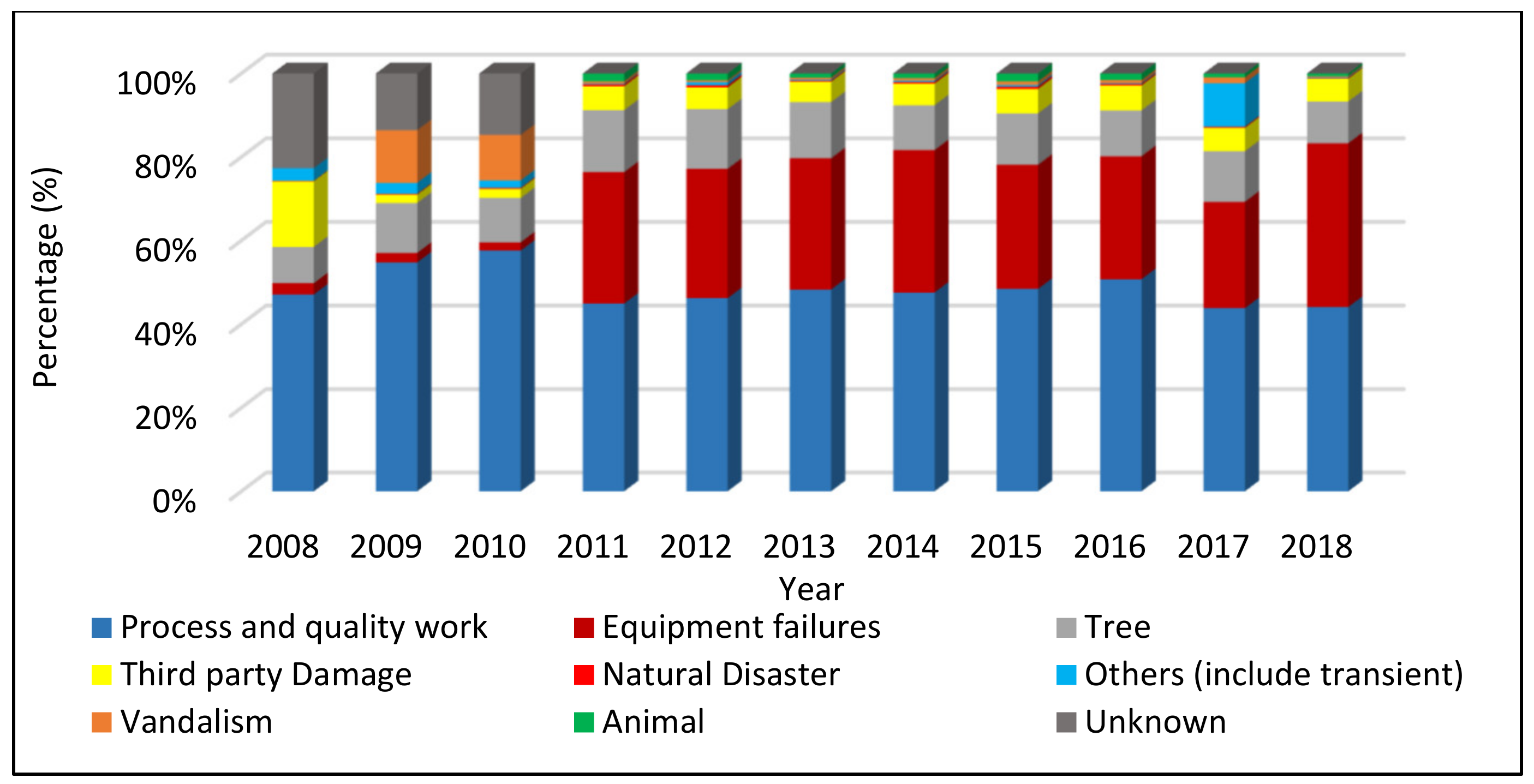
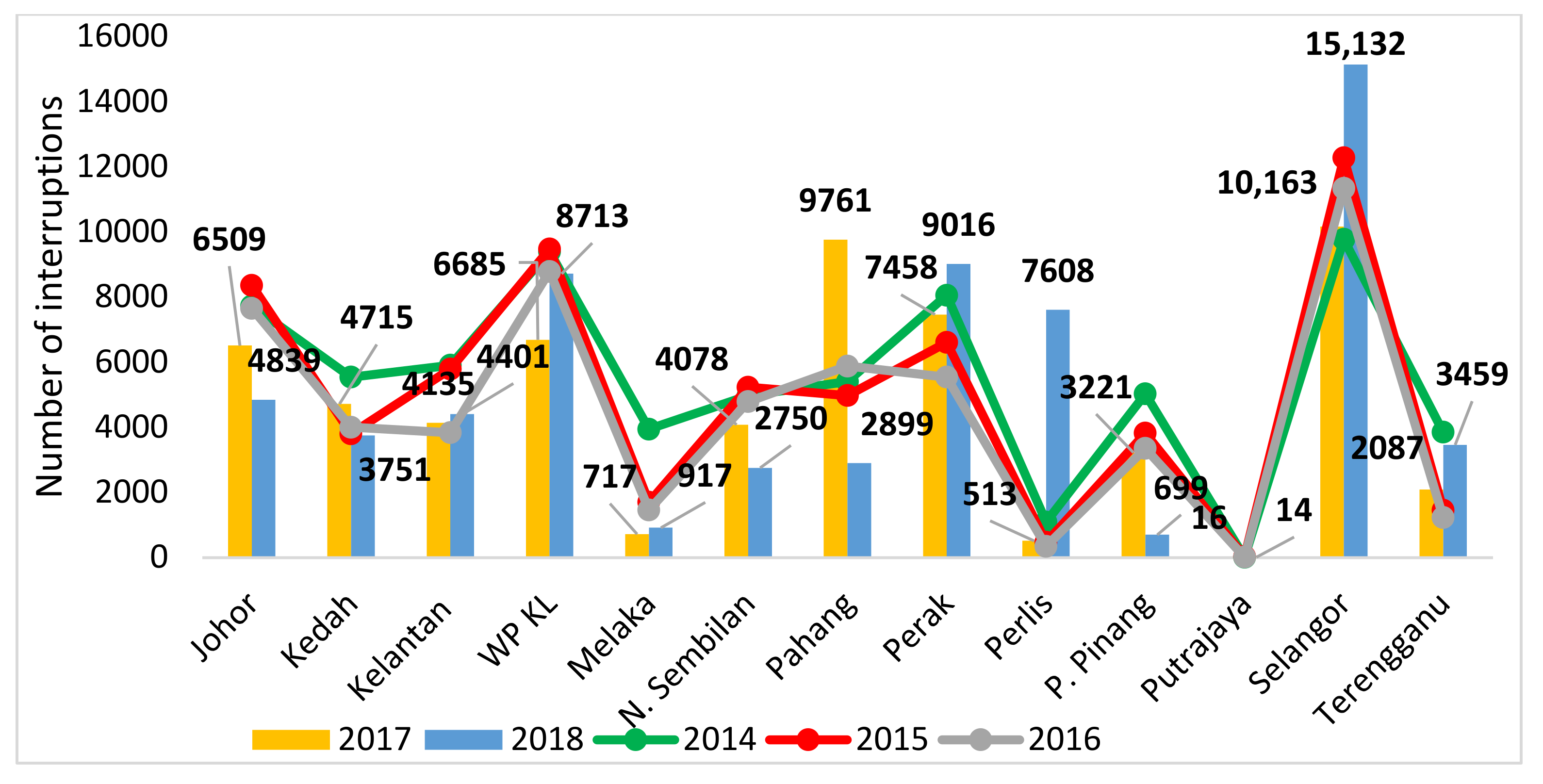
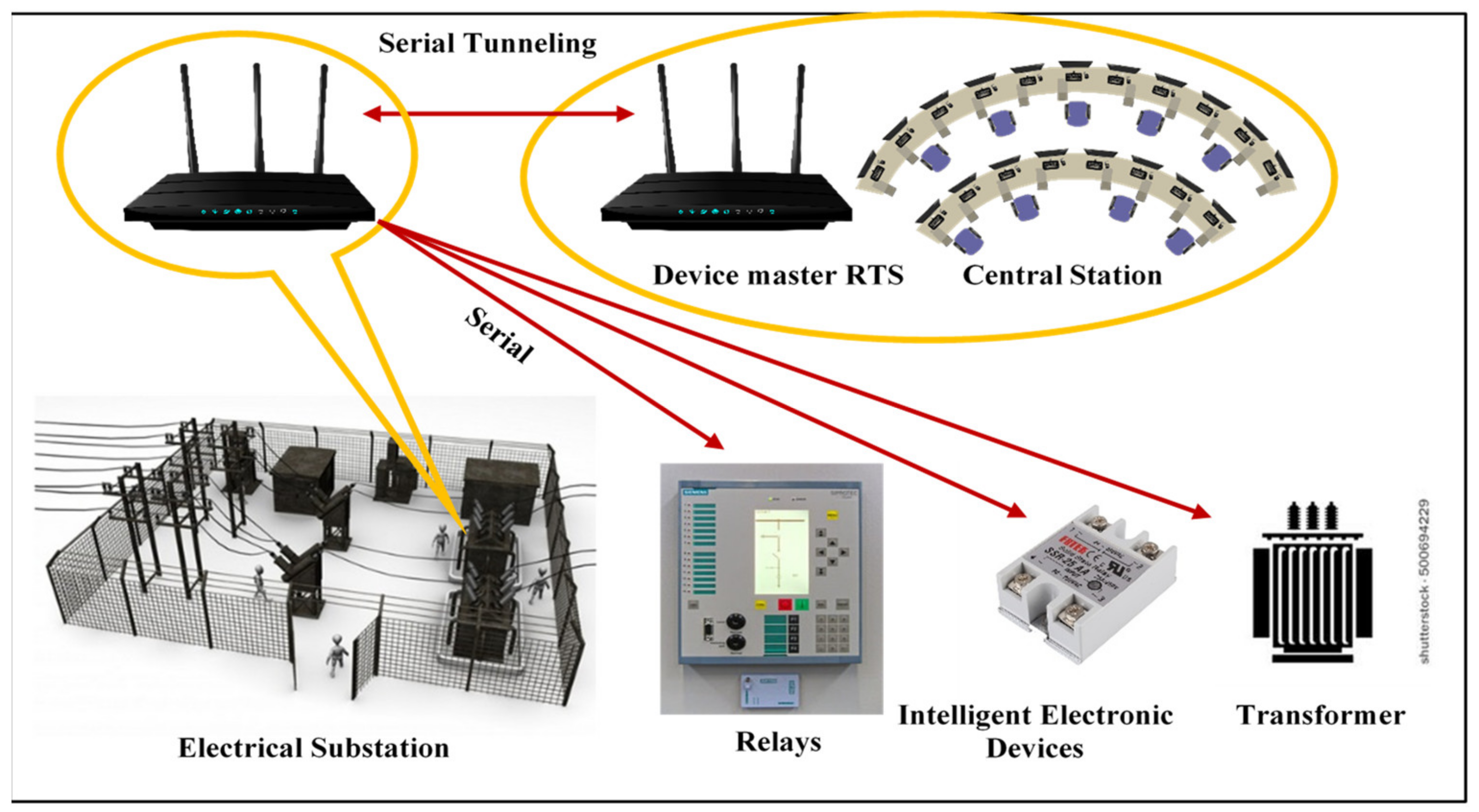

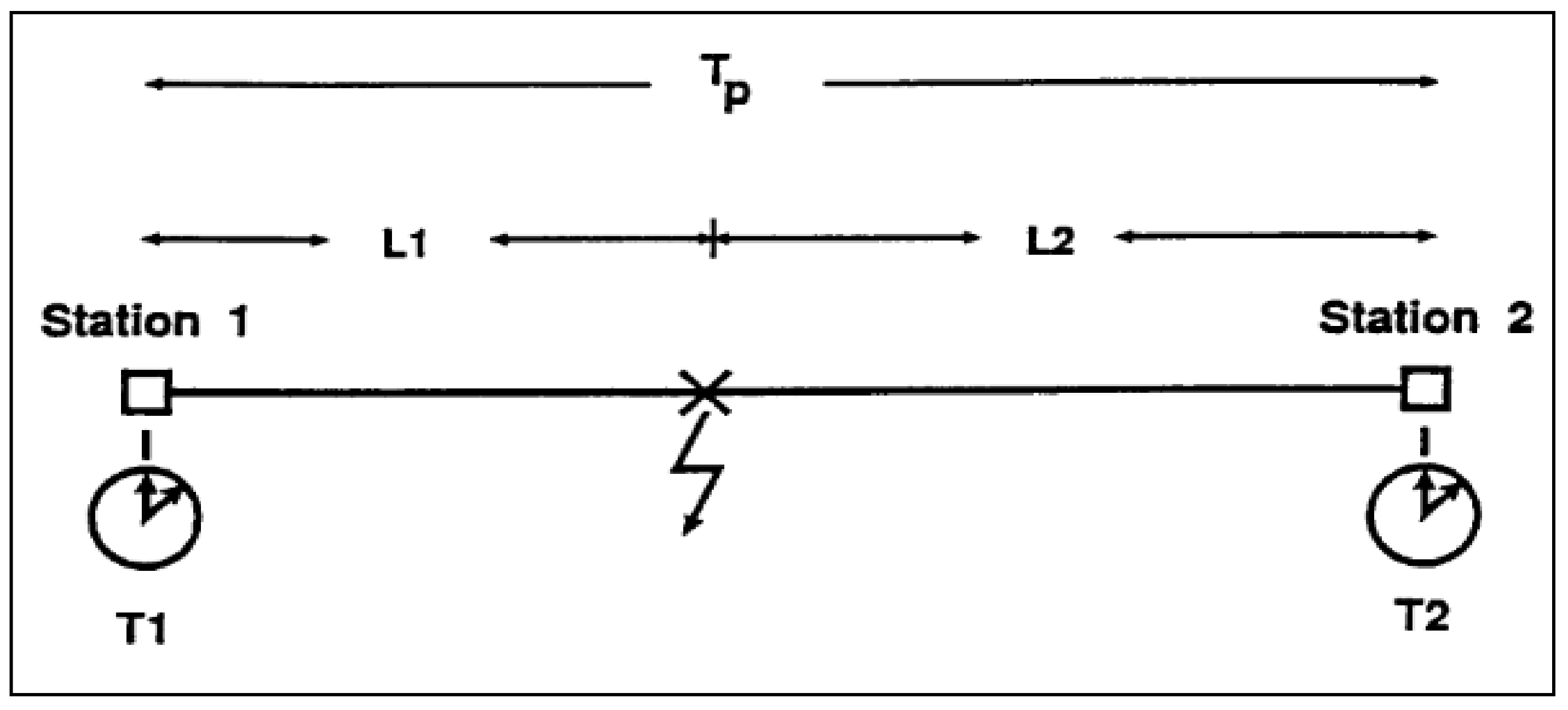
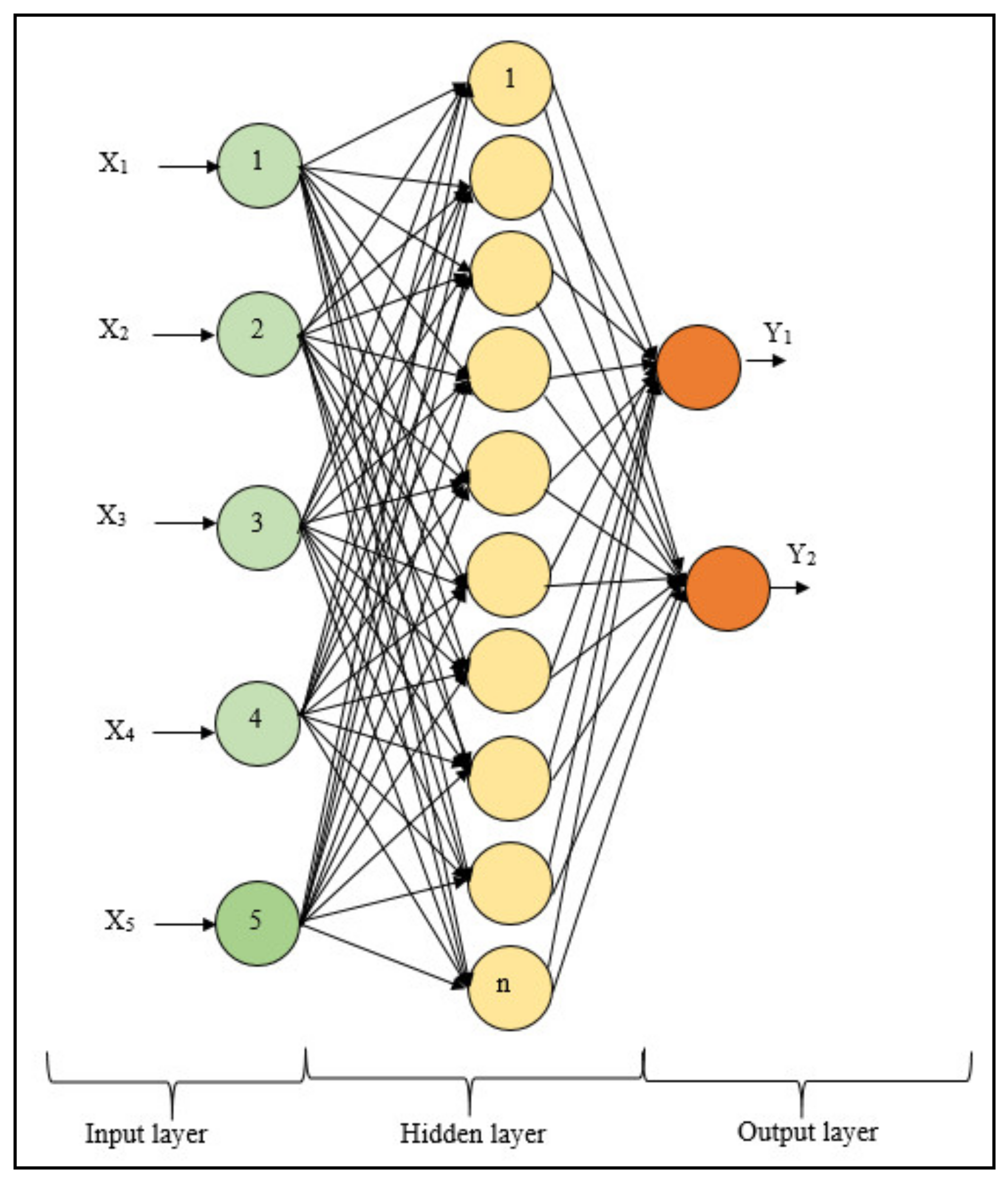
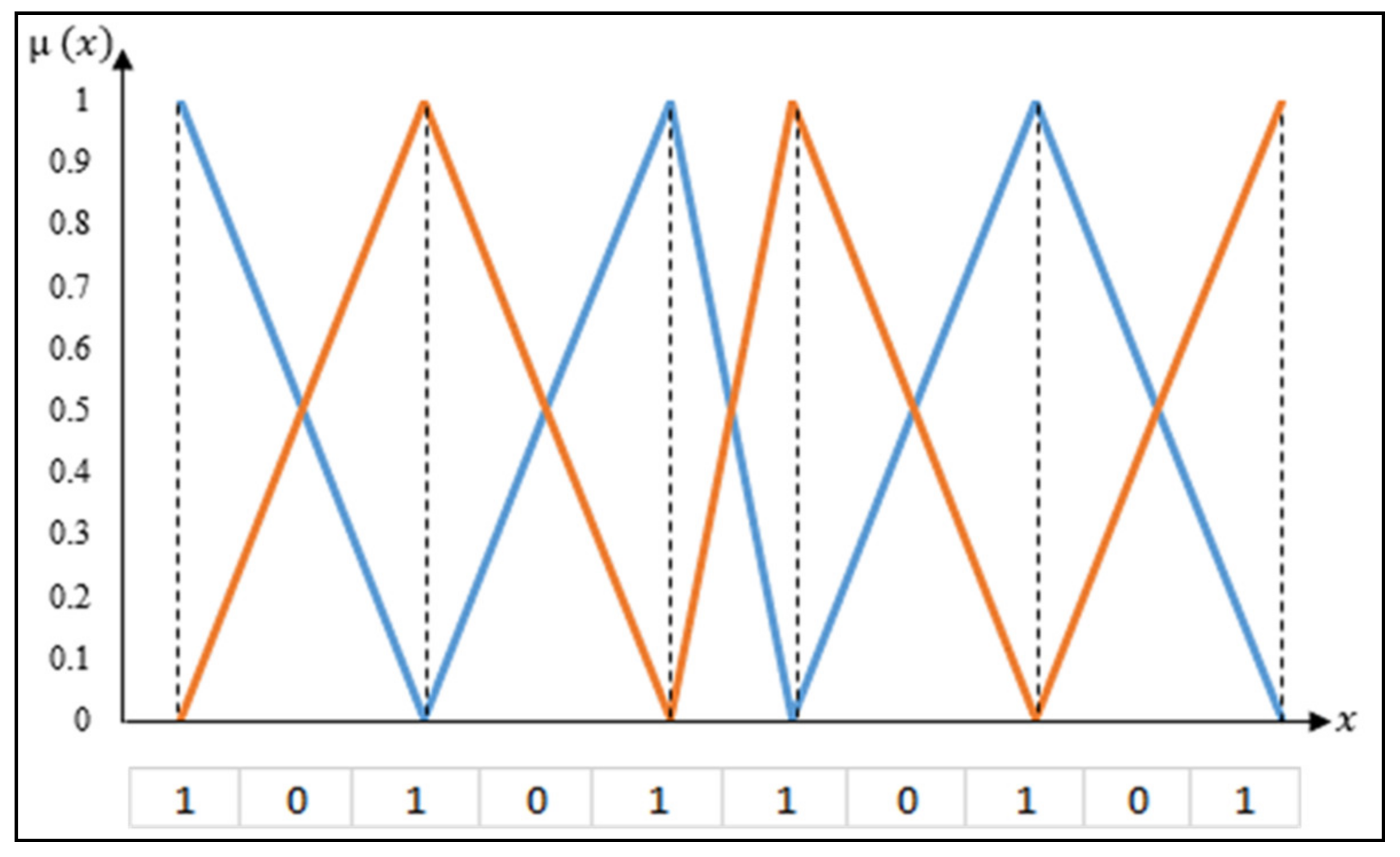

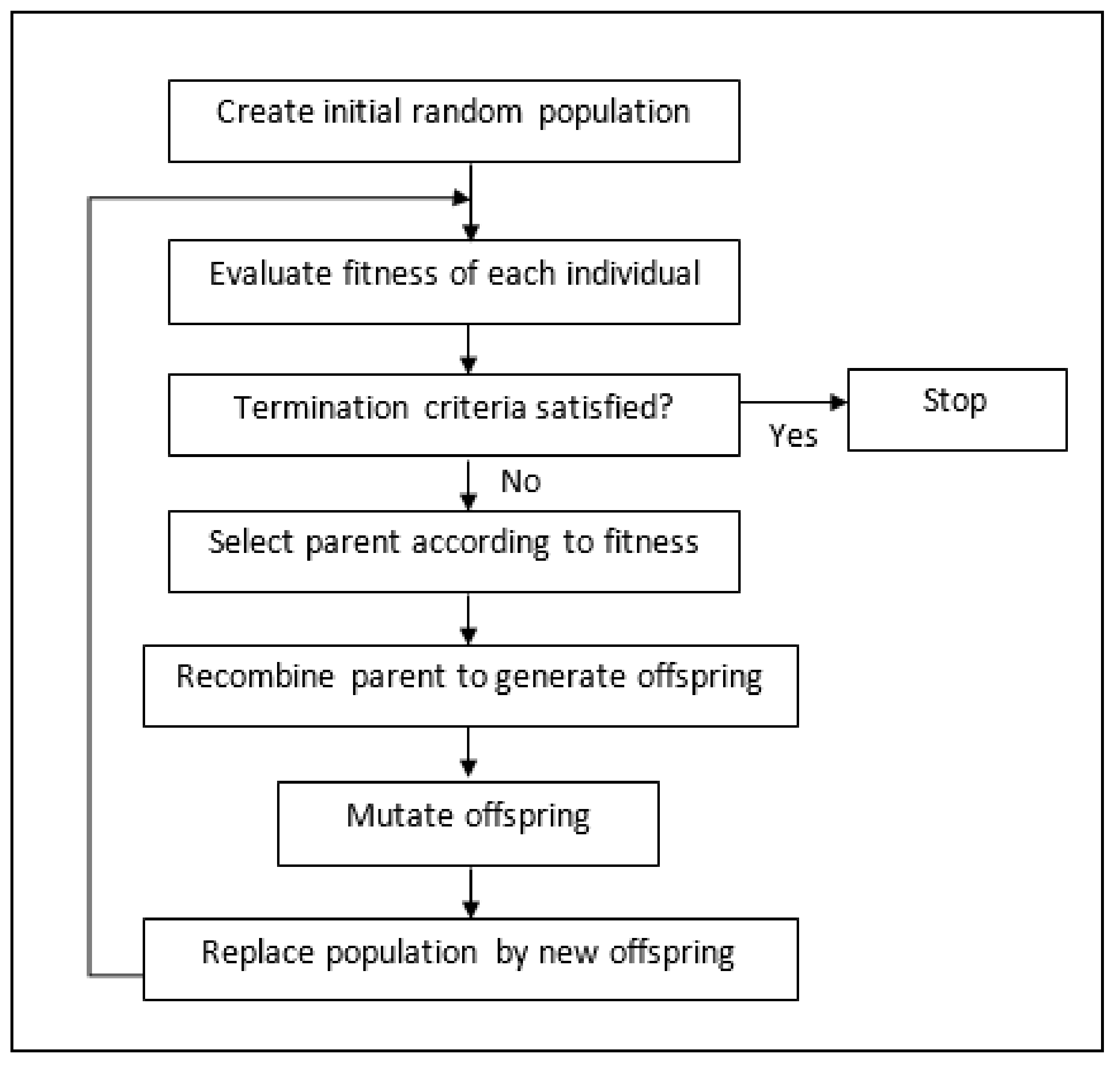

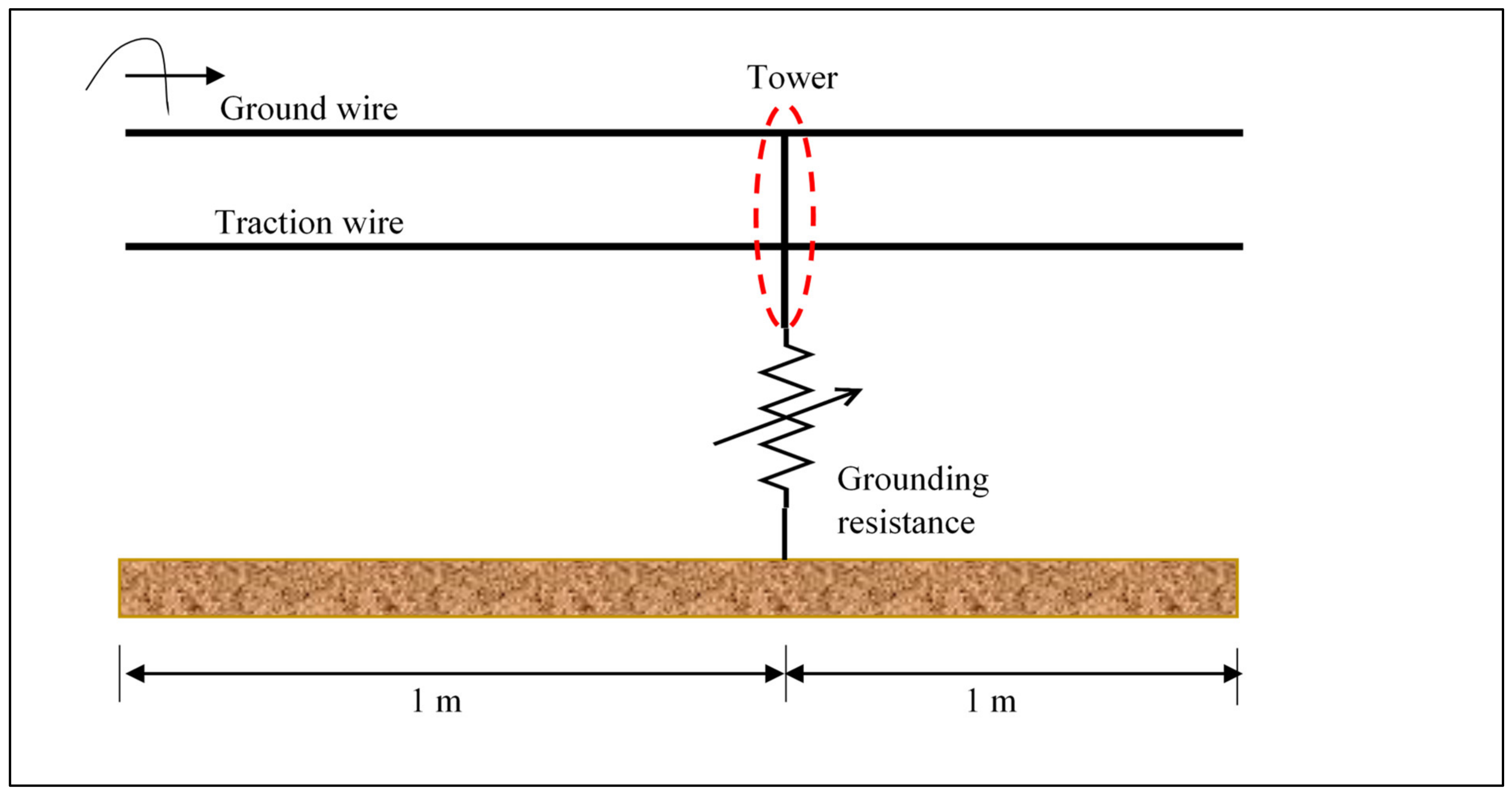
| Fault Causes | Year and Percent (%) | ||||||||||
|---|---|---|---|---|---|---|---|---|---|---|---|
| 2008 | 2009 | 2010 | 2011 | 2012 | 2013 | 2014 | 2015 | 2016 | 2017 | 2018 | |
| Process and quality work | 47.1 | 54.78 | 57.6 | 44.94 | 46.22 | 48.28 | 47.58 | 48.44 | 50.76 | 43.82 | 44.11 |
| Equipment failures | 2.7 | 2.3 | 2 | 31.44 | 30.95 | 31.41 | 34.08 | 29.7 | 29.43 | 25.46 | 39.19 |
| Tree | 8.7 | 11.96 | 10.6 | 14.86 | 14.29 | 13.46 | 10.75 | 12.32 | 10.99 | 12.12 | 10.02 |
| Third party Damage | 15.7 | 1.98 | 2.2 | 5.7 | 5.19 | 4.87 | 5.15 | 5.84 | 5.95 | 5.58 | 5.42 |
| Natural Disaster | 0.1 | 0.19 | 0.2 | 0.48 | 0.54 | 0.26 | 0.44 | 0.6 | 0.36 | 0.28 | 0.16 |
| Others (include transient) | 3 | 2.63 | 1.8 | 0.15 | 0.73 | 0.25 | 0.27 | 0.35 | 0.22 | 10.42 | 0.17 |
| Vandalism | N/A * | 12.6 | 10.9 | 0.55 | 0.43 | 0.47 | 0.62 | 0.83 | 0.7 | 1.42 | 0.29 |
| Animal | N/A * | N/A * | N/A * | 1.88 | 1.65 | 1 | 1.11 | 1.92 | 1.59 | 0.9 | 0.64 |
| Unknown | 22.7 | 13.58 | 14.7 | N/A * | N/A * | N/A * | N/A * | N/A * | N/A * | N/A * | N/A * |
| Category | Event-Based Classification | Typical Spectral Content | Typical Duration | Typical Voltage Magnitude |
|---|---|---|---|---|
| Impulsive | Lightning | |||
| Nanosecond | 5 ns rise | <5 ns | ||
| Microsecond | 1 µs rise | 50 ns to 1 ms | ||
| Millisecond | 0.1 ms rise | >1 ms | ||
| Oscillatory |
| |||
| Low frequency | <5 kHz | 0.3 to 50 ms | 0 to 4 pu | |
| Medium frequency | 5 to 500 kHz | 20 µs | 0 to 8 pu | |
| High frequency | 0.5 to 5 MHz | 5 µs | 0 to 4 pu |
| Author(s) | Ref. | Years | Verified by Experiment | Fault Types | Technique | Input Data | Error (%) |
|---|---|---|---|---|---|---|---|
| Rafinia et al. | [129] | 2014 | yes | SLGF, LLGF, LLLGF | DWT-ANN | Voltage and current | <1.50 |
| Adeyemi et al. | [130] | 2016 | yes | SLGF, LLGF, LLLGF | DWT-ANN | Current | <1.12 |
| Yang et al. | [131] | 2017 | NO | SLGF, LLGF, LLLGF | ANN | Current | <1.16 |
| Mahmoud et al. | [150] | 2018 | Yes | PV string, modules and MPPT fault | ANN | Voltage and current | <1.14 |
| Hassan et al. | [132] | 2020 | Yes | Grid connected photovoltaic fault | ANN | Current | N/A |
| Muhammad et al. | [151] | 2013 | Yes | SLGF, LLGF, LLLGF | FCE-Nets | Current and voltage | N/A |
| Palfi et al. | [148] | 2016 | No | Not mentioned | Fuzzy logic | (1) Ratio of consumer density to line length (D), (2) Ratio of number of smart consumer devices to total number of consumers (SM/CT). | N/A |
| Yadav et al. | [149] | 2014 | Yes | LG, LL, LLG, LLL, LLLG | DT-Fuzzy logic | Voltage and current | <2.00 |
| Deng et al. | [154] | 2013 | Yes | SLGF. | DWT-SVM | Voltage and current | <1.00 |
| Apisit et al. | [128] | 2012 | Yes | SLGF, LLGF, LLLGF | DWT-SVM | Current | N/A * |
| Radhakrishnan et al. | [132] | 2021 | Yes | SLGF | Ensemble DWT | Voltage | <12.0 |
| Ray et al. | [155] | 2016 | Yes | LG, LL, LLG, LLL | WPT-SVM | Voltage and current | <0.21 |
| Gu et al. | [161] | 2015 | No | SLGF | LS-SVM | Current | <1.10 |
| Liang et al. | [227] | 2018 | Yes | SLGF | GA | Voltage and current | <0.22 |
| Masoud et al. | [228] | 2012 | No | SLGF, LLGF, LLLGF | GA | Voltage and current | <1.00 |
| Jamali et al. | [229] | 2015 | No | SLGF | GA | Voltage | <2.00 |
| Sanad et al. | [230] | 2017 | Yes | LG, LLLG | WOA and GA | N/A | <1.00 |
| Rai et al. | [137] | 2021 | Yes | LG, LL, LLG, LLL | CNN | Voltage and current | <0.5 |
| Lei et al. | [138] | 2019 | Yes | Insulator and nest fault | Faster R-CNN | Image | <2.5 |
| Method | Advantages | Disadvantages | Application in DS | Computational Time Process |
|---|---|---|---|---|
| Travelling Wave [5,6,7,45,108] |
|
| Protection, fault distance accuracy, transient detection | Fast. |
| Impedance Base [45,118,119,120,121,122] |
|
| Protection, fault distance accuracy, low sampling rate detection | Slow due to the manually calculated |
| ANN [45,129,130,131,132,133,134,231] |
|
| Cyberspace security, fault and failure analysis, classification, and prediction. | Very fast |
| CNN [135,136,137,138,140] |
|
| Fault detection and location of distribution power system with DGs implementation | Very fast for signal but slow for image |
| LSTM [139,140,141] |
|
| Fault detection of distribution power system with DGs and multi-machine implementation | Depending on the hidden layer. The higher the number of layer, the slower the simulation time. |
| FL [143,144,145,146,147,148,232] |
|
| Fault position accuracy, power islanding detection, fault discrimination | Slow |
| SVM [45,128,154,155,156,157,158,231] |
|
| Forecasting, fault and failure analysis. | Very fast |
| GA [148,162,163,164,165] |
|
| Forecasting, fault classification | Not consistent due to most process are random |
| Method | Cost | Computational Process | Amount of Data Acquired | Sampling Frequency | Accuracy |
|---|---|---|---|---|---|
| TW | High | Fast | Small | Low High | Accurate |
| Impedance Base | Low | Slow | Small | Low | Less accurate |
| ANN | High | Fast | Big | Low and high | Depends on amount of data |
| CNN | High | Fast (sinusoidal signal) and slow (image) | Big | High | Accurate |
| LSTM | High | Dependent (slow when number of layer increase) | Big | Low and high | Accurate |
| FL | High | Fast | Small | Low and high | Depends on amount of data |
| SVM | High | Fast | Small | Low and high | Accurate |
| GA | High | Fast | Big | Low and high | Depends on amount of data |
Publisher’s Note: MDPI stays neutral with regard to jurisdictional claims in published maps and institutional affiliations. |
© 2021 by the authors. Licensee MDPI, Basel, Switzerland. This article is an open access article distributed under the terms and conditions of the Creative Commons Attribution (CC BY) license (https://creativecommons.org/licenses/by/4.0/).
Share and Cite
Asman, S.H.; Ab Aziz, N.F.; Ungku Amirulddin, U.A.; Ab Kadir, M.Z.A. Transient Fault Detection and Location in Power Distribution Network: A Review of Current Practices and Challenges in Malaysia. Energies 2021, 14, 2988. https://doi.org/10.3390/en14112988
Asman SH, Ab Aziz NF, Ungku Amirulddin UA, Ab Kadir MZA. Transient Fault Detection and Location in Power Distribution Network: A Review of Current Practices and Challenges in Malaysia. Energies. 2021; 14(11):2988. https://doi.org/10.3390/en14112988
Chicago/Turabian StyleAsman, Saidatul Habsah, Nur Fadilah Ab Aziz, Ungku Anisa Ungku Amirulddin, and Mohd Zainal Abidin Ab Kadir. 2021. "Transient Fault Detection and Location in Power Distribution Network: A Review of Current Practices and Challenges in Malaysia" Energies 14, no. 11: 2988. https://doi.org/10.3390/en14112988









